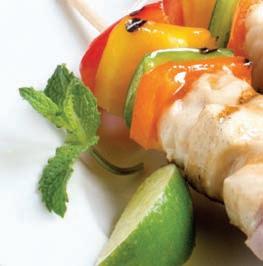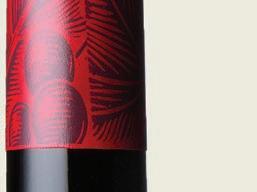LOCAL
Summer IS HERE FOOD


LOCAL
Summer IS HERE FOOD



THIS YEAR’S SUMMER ISSUE FEATURES STORIES THAT LET US DIVE into the season armed with plenty of ideas and recipes. For budding vegans, there’s a primer on going vegan (including nutrition needs). But meat-lovers aren’t being left out; recently, we’ve noticed an uptick in the number of restaurants offering steak on their menus. Throwing a steak on the grill is a perfect way to be outside in summer enjoying a refreshing drink. We talk to chefs and butchers about what to cook. There’s also an article about everything skewered. We take a closer look at kebabs, satays, the skewers themselves, and various marinades from around the world. We usually write about what’s new and happening in Victoria’s exciting restaurant scene (and we do in this issue), but I felt it was time recognize restaurants that have been quietly providing top-notch service and food for at least decade. They’ve had the time to develop a lasting style and substance that works for their customers. They deserve your attention and support.
Consider sustainability when it comes to buying shrimp. Avoid Asian shrimp farms that have little accountability. Instead, look at innovative ideas here in BC. Land-based seafood farms are gaining traction and don’t endanger the ocean environment. As a result, you will get freshness, clean eating, and a great replacement for seafood with unknown origins.
In the recipe department, check out this month’s ideas: a Middle Eastern take on eggplant with delicious labneh yogurt; light and tasty spring rolls that wrap summer’s bounty of fresh vegetables or fruits into little flavour bombs; and a lighter, less-calorific way to oven-bake fish in paper with herb flavourings.
Here’s wishing everyone a fabulous summer.
GARY HYNES FOUNDER & EDITOR
 PREPARED BY STAFF (REBECCA BAUGNIET IS OFF)
PREPARED BY STAFF (REBECCA BAUGNIET IS OFF)
Tofino’s Wickaninnish Inn has released a cookbook celebrating over 20 years of award-winning west coast cuisine. Featuring many memorable recipes of The Pointe Restaurant, The Wickaninnish Inn Cookbook showcases the culinary techniques, and the fresh, seasonal ingredients that have brought the property acclaim. Signatures recipes from current and former chefs are included, including those from current Chef Warren Barr, as well as opening chef Rod Butters, and Matthias Conradi, Andrew Springett, Duncan Ly, and many more. Recipes focus on sustainable seafood and local ingredients. The Wickaninnish Cookbook is now available in hardcover online at WICKINN.COM.

Le Dîner en Blanc Victoria is returning for the 6th edition. This season's spectacular chic picnic will take place in a new secret location in Victoria. Mark your calendar: July 27, 2018. To register go to:
VICTORIA.DINERENBLANC.COM/REGISTER
Galliano Island is hosting the Galliano Wine & Beer Festival on August 11th. A short charming day trip away finds you filling your complimentary engraved beer and crystal wine glass with lovely local brews while you nibble on tasty morsels created by some of Galliano's finest chefs. Take in the local farmers market on your travels and you could be sampling the goodness created right below your feet. Get your tickets at: GALLIANOWINEFESTIVAL.CA
The 21st Annual Feast of Fields Vancouver Island takes place this year on August 26 (1-4pm) at Kildara Farm (11293 Chalet Road, North Saanich). Feast of Fields are FarmFolk CityFolk’s annual local food celebrations and signature fundraising events, held each year on a different farm in the Okanagan Valley, in Metro Vancouver and on Southern Vancouver Island. Since 1994 FarmFolk CityFolk has celebrated more than 50 Feasts. All of our food and beverage participants donate their product and time to Feast of Fields – for which we are very, very grateful. Funds raised at Feast of Fields support FarmFolk CityFolk’s work to cultivate local, sustainable food systems across British Columbia. For more information on how you can help us support sustainable agriculture and celebrate local food in BC. FEASTOFFIELDS.COM
Be sure to attend Alpine Food & Wine Festival at the beautiful Raven Lodge atop Mt Washington in the Comox Valley on August 31st, for local wine sampling and gourmet foods prepared by celebrity chefs, while the mountain sun sets over Strathcona Park and local musicians serenade in the background.
MOUNTWASHINGTON.CA
Cult restaurant Hank's *A Restaurant has opened its second location in Victoria. Called Nowhere *A Restaurant, menu items can include: Lobster taco; Shrimp, lovage and ice cream; Lingcod cheeks, fiddlehead, dandelion, confit potato, wine, cream and things.#g4 1001, Douglas St, Victoria NOWHEREARESTAURANT.COM
The Summit Restaurant has a new direction and culinary team in place. Executive Chef, Ryan Bissell arrives from Vancouver, Restaurant Executive Chef Mario Gross, and Pastry Chef Mattias Conradi. Dishes currently include wild BC halibut with creamed leeks, wild rice, morel mushroom, saffron sauce; smoked double bone pork chop with bean ragoût, crispy polenta, thyme jus; and zucchini spaghetti with tomato concassé, marinara, vine ripe cherry tomato confit, basil pesto, italian chickpea fries and parmesan.
VILLAEYRIE.COM/SUMMIT-RESTAURANT
Locals Restaurant in the Comox Valley celebrates its 10th anniversary this year. A 3 -course Special Menu will be featured during July. 1760 Riverside Lane, Courtenay, BC. LOCALSCOMOXVALLEY.COM

The Victoria Wine Festival - This festival is directed at building the knowledge of the average wine consumer, and demonstrating new wines and acknowledging beloved wine standards to veteran consumers.
September 20-22, 2018 (Thurs & Fri 7:00 pm / Sat 3:00 pm). The Parkside Hotel & Spa, Victoria. VICWF.COM
Crush ~ A Fine Wine Affair - The Belfry’s annual fine wine live auction is a remarkable theatrical experience itsel Hosted by auctioneer Roshan Vickery and sommelier and wine educator Earl Wilde. Enjoy wine and cider tastings, hors oeuvres, silent auction packages for every price bracket, and live jazz music. This year’s live auction features the oldest vintage bottle yet: a Cossart Gordon Madeira Solera Boal from Portugal from 1845 valued at over $1200. But fear not: there will be more modestly valued bottles in the 20-lot auction from France, Australia, BC and elsewhere suitable for the entry level bidder as well. Tickets are $95 and all proceeds benefit Victoria’s leading professional theatre company and its beautifully renovated 19th Century building in the heart of Fernwood. October 21, 2018, Delta Ocean Pointe Resort
BELFRY.BC.CA/CRUSH
FOUNDER & EDITOR
Gary Hynes
PUBLISHER
Pacific Island Gourmet
CONTRIBUTING EDITOR
Carolyn Bateman
VANCOUVER CONTRIBUTING EDITOR
Julie Pegg
SENIOR WINE WRITER
Larry Arnold
PRODUCTION
Gary Hynes
DESIGN CONSULTANT
Aleya Samji
COPYEDITOR
Cynthia Annett
REGIONAL REPORTERS
Tofino Ucluelet, Jen Dart
Victoria, Rebecca Baugniet
Cowichan Valley-Up Island, Kirsten Tyler
Vancouver, Jennifer Carter
CONTRIBUTORS
Larry Arnold
Joseph Blake
Isabelle Bulota
Marie-Eve Charron
Cinda Chavich
Pam Durkin
Lindsay Eden
Lillie Louise Major
Sherri Martin
Elizabeth Monk
Daniel Murphy
Daisy Orser
Elizabeth Nyland
Adrian Paradis
André Rozon
Adrien Sala
Shelora Sheldan
Shawn Soole
Jill Van Gyn
Johann Vincent
Rebecca Wellman
COVER
Marie-Eve Charron (styling) & André Rozon (photo)
ADVERTISING DIRECTOR
Gary Hynes
SENIOR ACCOUNT MANAGER
Susan Worrall
MARKETING DIRECTOR
Ron Metella
FACEBOOK/EATMAGAZINE
TWITTER/EATMAGAZINE INSTAGRAM/EATMAG
For advertising and other inquiries: PHONE 250.384.9042, EMAIL editor@eatmagazine.ca
ONLINE EatMagazine.ca, TheEatJournal.com
MAILING ADDRESS Box 5225, Victoria, BC, V8R 6N4
STOCKISTS EAT is delivered to over 300 pick-up locations in BC. Visit our website for locations.
PRINTED IN BRITISH COLUMBIA EAT ® is a registered trademark.
Est. 1999
















HERE I AM ON A SUNDAY MORNING in the farmers’ market that’s wedged behind London’s posh Marylebone High Street. April showers have turned into a deluge. Undaunted by the downpour, I muck in with the locals who stroll amongst the stalls looking for crumbly English cheddar, blue-streaked, salty Stilton and local goat cheeses. There is locally raised beef, pork and lamb, and I encounter a fishmonger selling haddock and cod fillets and other fresh catch. Another table is piled with crusty loaves of homemade bread. One woman’s sole mission is to find early green asparagus. Steaming cups of tea, bacon rolls, scones stuffed with jam and clotted-cream buoy dampening spirits. Amidst all this best-of Britishness, though, I spot an enormous paella pan brimming with vivid red sauce, the most fragrant I have ever smelled. Golden-yolks with bright white rims float atop. Hardly your English fry-up.
A lanky fellow hovers over the red pool. When asked about the concoction, he informs me with a distinct French accent (turns out he is French-Israeli) that it is shakshuka, a slow-simmered tomato sauce laced with garlic, onion and hot peppers and spiced with cumin, sweet paprika and za’tar, into which eggs are sort of poached/baked.
Meaning to shake-up or mix, and as delicious as it is comforting, shakshuka’s roots lie in North Africa. During the 1960s, the sauce emigrated with Tunisians to Israel and now toasted challah or pita is dunked into what has become an Israeli breakfast staple. Popularized by Israeli-British chef Yotam Ottolenghi, Londoners are tucking into shakshuka in restaurants and from food carts and market stalls like this one as if it were their own. Later I read that New Yorkers, Portlanders and Torontonians have all cottoned on to shakshuka as well.

Yet I’ve rarely seen it back in Vancouver. Summer tomatoes and eggs being two of my beloved foods, I am an instant fan. Thoughts race ahead to August and the haul of plump sweet tomatoes I truck back every summer from the Similkameen. Firm juicy yellow, red and purple heirlooms of all sizes and shapes are for tomato salads and bruschette, colourful grilled flatbreads and pizzas. For weeks, I am endlessly chopping tomatoes into salsa. I freeze or bottle flats of overripe, mainly Roma tomatoes. (Opinion regarding freezing lies in two camps: to skin or not to skin. I prefer to remove the skins prior to freezing.)
About three years ago I took to making tomato jam and ketchup—not easy work but worth every painstaking minute of



skinning, seeding and slow cooking for the rich and piquant flavours that no commercial brands can match. This year, shakshuka will be a sure-fire addition to the tomato repertoire. So will caponata. This sweet and sour dish pops up on just about every menu in Sicily, from where, in fact, I am writing this piece. Its roots too hearken back to North Africa from whence it was brought, in the 12th century, along with almonds, oranges and fragrant spices among other foods. (The town of Marsala and the surrounding sand- and wind-blown landscape to this day conjures up Morocco more than Italy.) This legacy of mixing sweet with savoury is embedded in what the Sicilians term agrodolce. For instance, sardines and raisins are a popular combination. With caponata, the tomato takes backstage to eggplant, olives and capers. Nevertheless, tomato’s role is vital as it plays along with a jolt of vinegar, a hit of sugar, olives and capers. While here I’ve enjoyed caponata with less or more
tomato flavour. But its sweet/tart presence is always felt. Often enjoyed as a side dish, I prefer it on its own, slathered on a chunk of crusty bread.





Both shakshuka and caponata can be made with fresh tomatoes in season or, when cooler days roll round, from those you lovingly canned, bottled or froze.



Should a hankering (or hangover) one rainy Sunday morning demand something less exotic, I suggest that British fry-up—a couple of sunny-side-up eggs, homemade baked beans, good streaky bacon (or blood pudding) and thick, broiled or grilled slices of the juiciest, ripest tomato you can find.















OH, FROM THE MOUTHS OF FARMERS. When I reached out to our friends at PT Fruit Growers, one of our favourite Okanagan tree fruit growers, for some feedback about cherry growing, their first remark was, “Cherries are a very volatile commodity!” What a buzz kill.
Like all outdoor crops, cherries are at the mercy of the weather. The Okanagan, however, boasts Canada’s best cherry growing conditions, from soil to sunshine. Of all cherries grown in Canada, 95 percent come from B.C., and those B.C. cherries enjoy a reputation as the finest in the world.
The cherries coming out of the Interior boast some of the highest brix (sugar) content on earth—when circumstances are ideal. A grower’s dream is a long growing season of cool nights and warm to hot days, good soil and drainage and rain at just the right times. If it’s too cold during bloom (crops can be “frosted out”) or there’s too much rain during harvest (resulting in cherries splitting), all can be lost.
The Okanagan cherry season has been stretched from mid-June to mid-September due to the planting of staggered varieties, ready for harvest at different points in the season. This reduces the pressure for the weather to be perfect, allows labour to be spread out and maximizes income generation for growers.
Cherries are harvested ripe, often at the crack of dawn when temperatures are low, and many orchards use something called “hydrocooling” to lengthen shelf life and ensure quality. The process is simple and effective. Cherries are submerged in a cold water bath (0 -2 degrees Celsius), instantly dropping their temperature and shocking (killing) up to 80 percent of bacteria that may be present. If cherries are simply put into a cooler, it takes about a day for them to cool down sufficiently, during which time bacteria is breeding and shelf life shortened.
PT Farms grows a dozen cherry varieties, but our experience on Vancouver Island is that the lovely Lapin wins the popularity contest, offering deep, dark flesh and both crunch and sweetness. The Skeena is a dark horse you should try if you have the opportunity, and the golden-fleshed Rainier is quickly gaining popularity (and is stunning canned). Whether you buy cherries for sweetness or crunch, canning or pie, there’s a cherry for everyone.
So growers may be right about the volatility of cherries, and we thank them for forging ahead regardless, but the world is right about how lucky we are to be literally the best place on earth to enjoy them.
DaisyOrser is co-owner of The Root Cellar Village Green Grocer


Of the hundreds of cherry varieties, Okanagan growers focus on about a dozen that thrive in our growing conditions and provide staggered harvest times for a lengthened season. A half dozen of these are most commonly found at local markets. .

CHELAN: Firm in texture with a mahogany-red skin. Also known as “black cherries.” Early variety with long shelf life in comparison to counterparts. Enjoy fresh out of hand.
SKEENA: Dark red to almost black. Large and firm with strong, high-quality flavour. Delicious eaten out of hand or baked in recipes.
VAN: Firm, medium-sized cherry with dark colour. Beautifully sweet in flavour. Excellent for canning, baking or eating out of hand.
BING: Most common and versatile cherry in North America. Deep garnet-red skin with a distinctive heart shape and a sweet and vibrant flavour. Enjoy out of hand, in jams and jellies and baked in pies.
LAMBERT: Large and round cherry with a deep ruby-red colour that’s even throughout and semi-sweet flavour. Excellent eaten out of hand or in cooking and baking because it maintains its texture.

SANTINA: Early variety, oval-shaped with a beautiful bright skin and sweet flavour. Eat out of hand or in sweet cherry recipes.
SOUR: Tart in flavour and thin-skinned with bright and glowing colour. Best cooked or prepared before eating. Firm cherry that holds up when cooked, baked or otherwise. Enjoy in jams, pies and ice cream.
LAPINS: Large in size with deep red flesh and excellent firmness. Longer shelf life in comparison to other cherries. Rich sweet flavour makes it ideal for sweet cherry jam or jelly. A late-season winner and my personal favourite.
here are the casual capsaicin seekers who go for the occasional dab of Sriracha, and then there are those leaning towards the masochistic who look to every meal as a test of pain. Either way, Victoria has options when it comes to locally made hot sauces.
These days, spicy foods can be found in the most unlikely places—Cheetos and Slurpees, for instance, ready to offer a peppery bite to unsuspecting snackers. As early as 1912, an American pharmacist named Wilbur Scoville decided the world needed a way to measure the intensity of spice and devised a method for measuring the capsaicin pungency of a pepper. Scoville would make an alcohol extract from a dried pepper sample, then dilute the extract with sugar water. The number of times an extract can be diluted before a taste tester can no longer detect any spice is a pepper’s Scoville Heat Unit (SHU).
Not everyone agrees with Scoville’s method; there’s some degree of subjectivity when relying on taste testers. Other more scientific ways of measuring capsaicin exist, yet the Scoville Scale remains the most popular.
In Victoria, while options abound for hot sauces, scientific testing labs are scarce. In lieu of official ratings, here’s what local makers had to say about their own sauces, as well as my own comments.

Rebecca Zhang’s hot sauce comes from an old family recipe that was passed down to her from her mother. After moving from China in 2012, Zhang offered a sample of her sauce to her husband immediately knew she had something special. It’s no surprise this sauce starts off smelling floral and tasting sweet. The fruity flavours of apple and pear really sparkle through before the chili warms the tongue. The sauce finishes with a pungent garlic kick. With its visible bits of garlic and onion, the sauce has a consistency closer to a loose salsa. “We haven’t had our hot sauces officially tested on the Scoville Scale,” says Zhang, “but we estimate our medium and hot varieties to be somewhere in the 500 to 2000 range, based on other product ratings.”
This sauce started as a labour of love. Liz Newton was on a mission to make a sauce that was spicy but also flavourful enough for her husband, Jon—a.k.a., Dad. After months of testing in her Cowichan Valley kitchen, she devised a winning recipe. They decided to start selling the sauce at the Moss Street Market in 2010. Today, they have five different levels of spice ranging from their Rainforest Awesome Sauce (mild) to their OMG! It’s Awesome Sauce (XX spicy).
The Embers (medium) variety has an extremely smoky fragrance, reminiscent of summer barbecues. The taste starts off a tad bitter (I’m assuming because of the smoke), before opening up to become warm and peppery. The sweetness of the balsamic and sun-dried tomatoes comes through to balance out the smokiness and spice.
I asked Newton if she had ever had her sauces tested on the Scoville Scale. No, she replied. Like many, she has a problem with the scale’s subjective nature, and the high costs of testing. What she could say is that their Wildfire Awesome Sauce (hot) is a little hotter than Sriracha (1000-2500 Scoville) and rather more flavourful.
Small batches of this amazing Vancouver sauce are made in three flavours: Cilantro Lime, Clean Mango and Beet and Tequila. Best friend team Jordan Hocking and Justin Cox combine elements of both Mexican and Thai food to devise some great combinations.
Their Cilantro Lime is a brilliant shade of green and smells of citrus and herbs. The flavours are bright and clean, with the herb coming through in a big way. The spiciness seems unassuming, balanced nicely by the acidity, but will build on itself the more
you eat—which you’re assured to do. Hocking says they haven’t tested the sauce, but Chilly Chilies in Ottawa carries it and have rated it on their chart at a max of 4000 Scoville Units. “I don’t think our sauces would win any heat contests,” she says, “but I hope we will win some folks over on flavour.”
flavours, offset by the vinegar. This sauce is less sweet than others I’ve reviewed so far. There’s no added sugar, but some natural sweetness comes through in the carrot and bell pepper.
Chris Rodgers worked at Shaw Cable for 10 years before he was abruptly laid off. He had the option of scrambling to find another computer job, or he could take his newfound spare time to do something he wanted to do. He chose the latter.
“I would bring my hot sauce to the potlucks and all the guys said, ‘This is amazing! Do you sell this?’” He started making it for people he knew before taking to the local markets in 2016.
While he says his sauce is technically closer to a chili oil, people would be less sure what to do with it if he labelled it as such.
Unlike the others, Rodgers has had his sauce tested; it registering around 25,000 Scoville Heat Units. He uses mixed manzano peppers seeds to make four different flavours. In the Black Tara, chunky seeds float in crimson-coloured olive oil that, once refrigerated, solidifies somewhat into a spreadable paste. The combination of the olive oil and the peanuts gives the sauce a rich smoothness. Garlic rounds out the richness of the oil and the peanuts, balancing the heat intensity of this one.
Local musicians Roy Vizer and Dougal McLean started making Zing Tang in 2014 when Vizer’s mother-in-law gifted him a surprise crop of rhubarb. Not being one for sweet things, the team got creative and started making hot sauces instead. Local rhubarb is paired with habanero and plenty of citrus. While this sauce smells fruity, there is a kick of spice from the habanero before the acidity of the orange mellows out the flavours. Despite the rhubarb, the sauce tastes more of citrus, while still having a good balance of tang and spice.
Fuego Old Town Eatery opened in 2015 when its sister restaurant, Café Mexico, suffered a serious fire. You could say hot sauce came to them naturally. They’re no strangers to heat—fuego meaning fire in Spanish.
“Our hot sauce is hot, but not so overly hot you can’t taste your food,” says Fuego chef Armanda De Torres. “It’s just a good sauce and it works.” Fuego started bottling its house sauce in 2016 using habanero and carrot to create a rich orange colour. Today, De Torres says she’s noticed young people favouring hot sauces over plainer condiments. “My grandson is 15 and he’s collecting sauces now. He used to love ketchup, but now it’s this.”
As promised, the habanero shines through with nice clean
Rodgers says he has enjoyed spicy food since he was a kid, despite his family’s less adventurous palates. Asking why some people become obsessed over spicy food, he says, “If you do anything long enough, or consistently enough, you will start to develop a tolerance to it. It’s almost like a drug.”
One rainy night camping on the Juan de Fuca Marine Trail, husband and wife pair Eben and Karita Sedun had their sleep abruptly cut short by a noisy owl. “It was terrifying, exhilarating, an unforgettable Vancouver Island experience,” they explain on their website. They hope their hot sauce is a similar experience for those using it. The couple make their sauces in Qualicum Beach, and Owl’s Screech is made with BC-grown scotch bonnet peppers.
With a mix of yam, garlic, rosemary and cashew, this sauce has a complex depth of flavour. Some smoky notes come through, along with a creeping spice level that stays with you for some time. For me, the ginger and maple came through less than hoped, but the depth of flavour here keeps you coming back. While they have not had their sauces tested on the Scoville Scale, they do know the rating of the scotch bonnet peppers they use: a whopping 100,000-350,000! The other ingredients would bring that rating down, but the creeping heat in this sauce is real.
Hot sauce, also known as chili sauce or pepper sauce, is any condiment, seasoning, or salsa made from chili peppers and other ingredients. —WIKIPEDIA






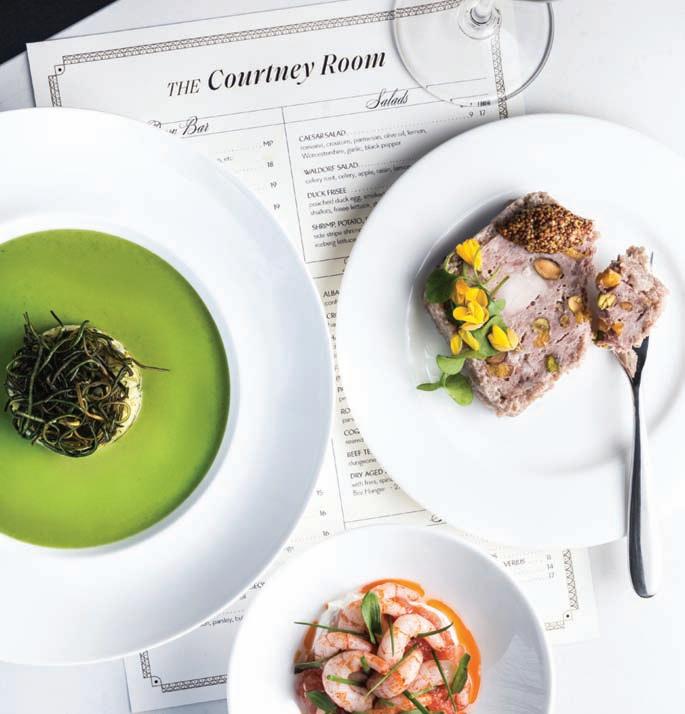
There has never been any doubt that Matt Phillips is a beer fan. One of the first brewers to strike out on his own in Victoria 17 years ago, Phillips has been on the front line of beer making, carving his path for craft culture. Now with his latest venture, he has lifted the bar yet again.


As the first phase of a long-term plan for a complete “beer experience,” Phillips Brewing Co. has opened a tasting room. Adjacent to the previous growler bar and former front entrance of the brewery, the tasting room is positioned on the corner of Government and Discovery, with large windows facing both streets. The space is big. The main entrance is adorned with various Phillips-branded paraphernalia and swag and flanked with refrigerators and a growler filling station manned by an employee ready to answer your questions. Around the corner you’ll find a long bar to sidle up to, with several other tables for drinking with strangers who (presumably) share an interest in craft beer. “I’ve always wanted a tasting bar where people can learn about our beers from bartenders who understand them,” says Phillips.
For a guy who has worked hard and found success, it’s interesting to note the small shade of trepidation in his voice when he explains his plans. It’s not that he isn’t confident. I think it’s more that he really wants people to get it. The “beer experience” feels like a passion project that will help customers peer behind the beer curtain and learn more about his process and personal approach. It’s exposure, so it’s easy to understand why he would want to get it right in a city like Victoria with its army of educated beer lovers.
A beer flight of four tasters runs $8 (16 ounces in total). My preference, a 10-ounce pour, will cost you four bucks. If beer isn’t your thing, you can sample Phillips’s crafted Stump gin, $6.75 for a single (straight or mixed with an artisanal tonic) and $9.75 for a double. Or go nuts with a soda. There are classic beer bar snacks like a chocolate porter sausage (a.k.a. pepperoni), doughy pretzels and a mixed cheese plate. The glassware is great, too. Rather than a flute, which feels small and temporary to me, glasses are shaped in a way that makes them easy to hold, wide and open at the top like a traditional pint glass. It feels good drinking from them.
The new tasting room is a great addition to Matt Phillips’s vision. It’s also a congenial way
to reconnect with Phillips if you haven’t in awhile. Not that I haven’t been enjoying Phillips beer for years, but with a modest price for a taste of something interesting in a cool room, it’s easy to reconnect with some old favourites or experience something original. The 12 taps offer fan favourites as well as a number of fresh or new beers, which will change regularly and seasonally. Feels like a big win for Phillips and the city.
ADRIEN SALA



619 COURTNEY ST., 250-940-4090, THECOURTNEYROOM.COM







Hotel restaurants face the fine balancing act of being all things to all customers—feeding travelling guests while aspiring to lure locals for destination dining. It looks like the Magnolia Hotel might have finally nailed that tricky tightrope walk with the latest incarnation of their dining space, The Courtney Room.
The boutique hotel’s new restaurant fills the same real estate that housed others before it (the latest being Catalano), but it’s been completely gutted and re-imagined as a sleek, elegant and modern French brasserie, with a formal upstairs menu and a more casual bistro and raw bar below. Think freshly shucked oysters and seafood towers ($95), a $74 chef’s tasting menu (add wine pairings for $40 or caviar service for $39 per person), and dry-aged organic beef, all from the finest local sources.
With a stellar staff of pros, many with experience from other notable hotels and restaurants, it looked like a bit of a dream team at the opening in late April.
For one, there’s chef Sam Harris at the helm of the kitchen crew. His latest gig was at award-winning Agrius, but he’s also cooked at the Relais & Chateaux Sonora Resort, the Four Seasons Resort Whistler and Bishop’s in Vancouver. Sous chef Chris Klassen is another Agrius alum, while pastry chef Yuka Watts spent four years with Vancouver’s Thomas Haas.
In the front of the house, there’s some notable provenance, too—from restaurant food and beverage manager Adrian Gatt (late of The Wickanninish Inn in Tofino and Claridge’s in London) to super sommelier and assistant manager Anna Romeyn and maître d’ Ben Anderson.
Our dining experience during the early soft opening stage is a chance to try Harris’s bistro menu, featuring classic appetizers like duxelle-stuffed mushrooms and Oysters Rockefeller to larger plates of coq au vin as well as house-made sausages with mustard spaetzle, duck confit and barley cassoulet.
We start with Albacore Tuna Ceviche in a colourful cilantro green cure scooped up with crispy pork rinds, then move on to the salads. The Waldorf is an inventive take on this classic, a fresh tangle of celeriac “spaghetti” with crunchy green celery, raisins and apples in a lemony vinaigrette. The Duck Lyonnaise would make a lovely lunch on its own, with slices of silky house-smoked duck breast and a perfectly poached duck egg atop a pile of fresh frisée.
For mains, we opt for the grilled Rockfish Meunière with light, choux pastry Parisienne gnocchi and classic Steak Frites. The latter features organic Cache Creek flat iron, cooked rare and sliced across the grain with natural jus. Dessert is an array of little French pastries: a light madeleine, nutty financier and crusty canelé followed by a selection of creative chocolate truffles.
The dining room menu expands to include additional dishes, from vichyssoise and Northern Divine caviar to the à la carte steaks, pork and rack of lamb served with extras like cauliflower gratin, roasted beets or sautéed spinach.




Of course, as this is a hotel restaurant, it’s also open for breakfast and lunch, whether you’re craving steak and eggs, classic crêpes or a Croque-Madame ham and cheese sandwich smothered in Mornay sauce.

After a four-month, $1.5-million renovation, the new space is resplendent in a deep charcoal, soft grey and clean white palette, with soaring ceilings and architectural details reminiscent of an upscale Parisian bistro. The room is bright by day and buzzy around the marble cocktail and wine bar, where oysters are shucked to order. Upstairs, crisp linens and a glassed-in wine cellar add a touch of formality.
This year the elegant Magnolia Hotel turns 20, and The Courtney Room is a lovely gift for us all.
CINDA CHAVICH
top: The Courtney Room, Magnolia Hotel - DUCK LYONNAISE SALAD; CANELÉS DE BORDEAUX, MADELEINES AND HAZELNUT FINANCIERS
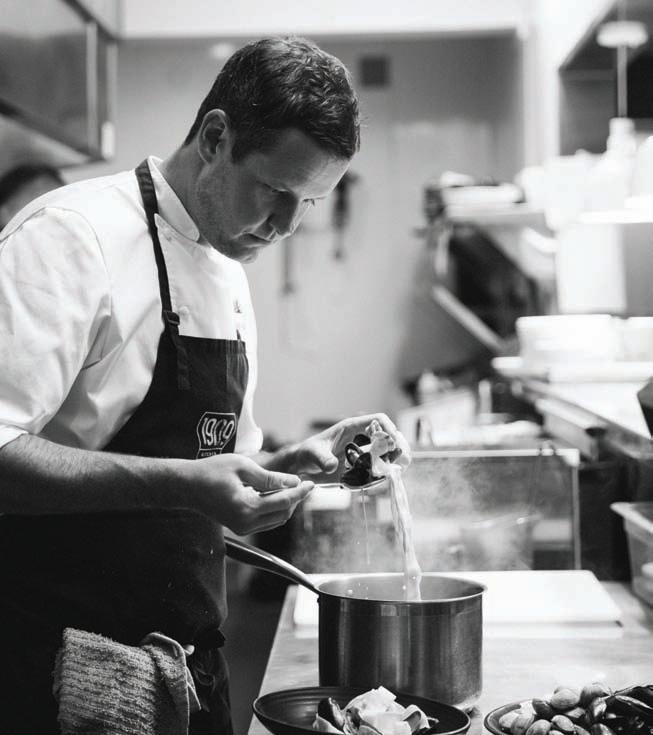

below: 1909 Kitchen and The Hatch Waterfront Pub at Tofino Marina Resort - SIDE STRIPES, APPLE, AVOCADO, CUCUMBER, JALAPEÑO, AIOLI, LEMON, ICE BERG, CHIVES, COCKTAIL SAUCE; CHEF PAUL MORAN IN HIS KITCHEN.


Driving up-Island on a sunny morning in May, I was eager to see the re-development at Tofino Marine Resort and to sample chef Paul Moran’s cuisine at the resort’s 1909 Kitchen. My son Jesse has been a chef in Tofino for years, running his own Wildside Grill for more than a decade, and he was impressed with Moran’s cooking. Jesse is usually very critical of big-name chefs and fine dining in general, so I was excited to dine at 1909.
Pale green maple and alder catkins and wild dogwood flowers were putting on a show as we drove over the summit past glassy lakes and into the rainforest on the coast. On days like this, mid-week without traffic, I’d almost pay to travel by car to Tofino.
After checking in to our newly renovated suite, we booked a roundtrip for the next morning aboard the lodge’s adventure tour boat to Hot Springs Cove with a knowledgeable, indigenous guide and reserved a table at 1909 Kitchen for a meal after our long soak in the hot springs.
That night we ate at the resort’s Hatch Pub, a 90-seat floorto-ceiling glassed clubhouse (plus a 65-seat patio overlooking the marina) inspired by a pair of fishing-obsessed, hockey-star co-owners, one-time Canucks Willie Mitchell and Dan Hamhuis. They teamed up with marina developer Andrew Purdey to buy the four-acre, 63-room motel,
restaurant and marina in the heart of Tofino in 2016. After extensive renovations, they installed chef Moran in the kitchen with a Muguni wood-fired oven that turns out almost a dozen pizza offerings and locally sourced, classic pub food for The Hatch as well as elegant, shared-plate fine dining cuisine in 1909.
Vancouver restaurant royalty David Hawksworth mentored the Okanagan-bred Moran until the young chef left for France to work in kitchens in Paris and Provence and continued working travels in Montreal, Mexico City, Whistler and a Haida Gwaii fishing lodge before coming to Tofino Marine Resort last year.

Ocean- and forest-foraged ingredients are featured prominently on 1909 Kitchen’s menu, and after our hot springs soak, we feasted on wild mushrooms on toasted rosemary bread, soft boiled quail eggs, lemon and herbs; albacore on thinly sliced white radish tacos, white soy, Bamfield nori aioli and crispy bits; and wood-roasted-until-tender local squid drenched in smoky, paprika-like achiote rub and served with a charred onion and ginger puree and a radish salad topped with bits of local Dungeness crab.
Chef’s understated touch with fresh, local ingredients was also evident in vegetable-forward small plate offerings like his warm asparagus and baby romaine hearts with green
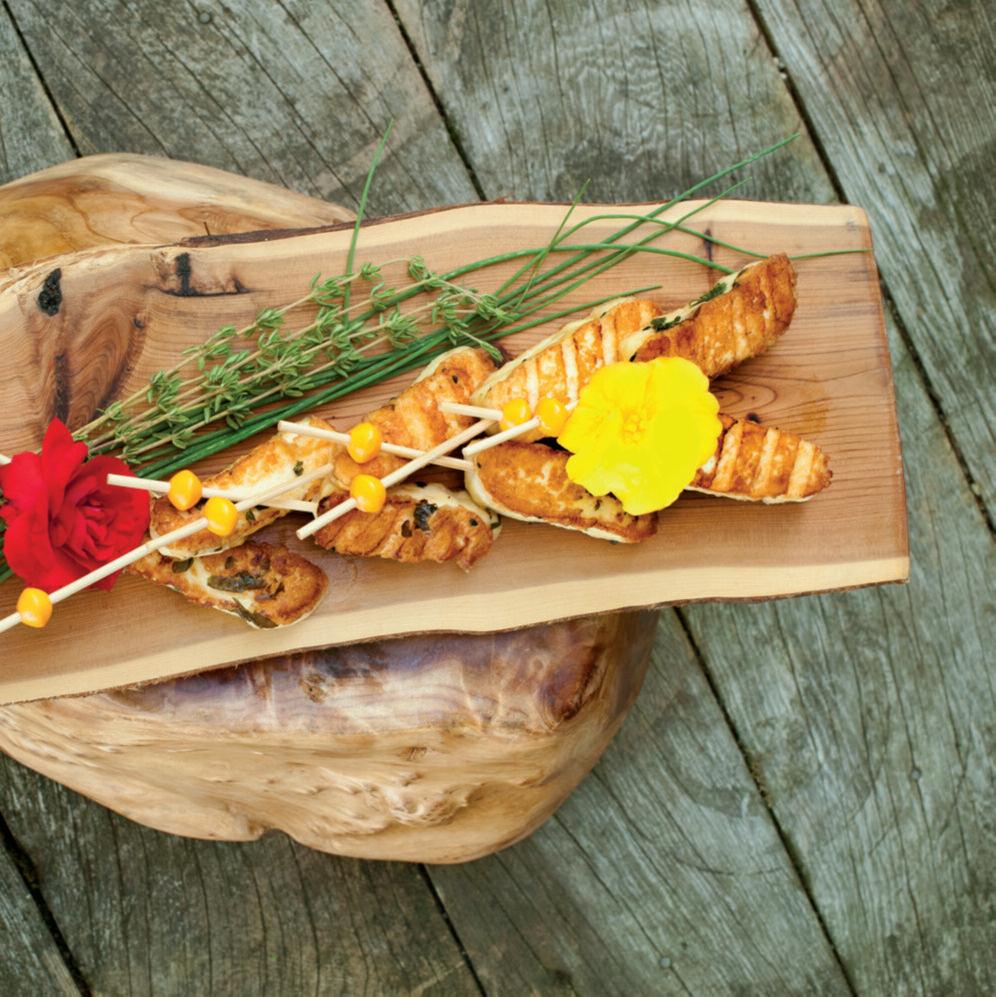

garlic dressing, crispy sourdough crumb and padano cheese.
“I got tonight’s asparagus, albacore and shimeji, shiitake and king oysters mushrooms from Bobby Lax of the Tofino Ucluelet Culinary Guild, a chef-supported co-op, but I come from a family of foragers,” Moran explained, “and I gather many of our ingredients. As a boy I started foraging morel mushrooms with my dad, and my brother still works as a forager.
“The desserts reflect my kitchen experiences in France,” chef continued as he served us a dessert sampler that included tiramisu, a custard sandwich pressed between sweet black sesame, pistachio ice cream and salted caramel ganache, yogurt cloud with a topping of fresh strawberries, meringue wafer and wood sorrel. “My tiramisu includes espresso-laced lady fingers with mascarpone topped with a chocolate tuile. That’s my favourite. I could eat it every day.”
Me too. 1909 Kitchen is a highly recommended dining experience, and I can’t wait to revisit Moran’s culinary genius this summer.—JOSEPH BLAKE
Plus, a restaurant dedicated to the singular cuisine of Yunnan Province, China.
546 FISGARD ST. NEAR GOVERNMENT, 778-265-8868
At last. I am almost giddy with excitement that Victoria just got a jolt of Vancouver and Seattle-level Chinese dining with the emergence of the distinctly regional Chinese Little Yunnan Restaurant. With China’s 33 provinces and regions covering a land mass of 9.6 million square kilometres, and climates ranging from sub-Arctic to tropical, its cuisines can be as distinct as different European ones, and regional restaurants allow for more in-depth exploration of food and culture. Little Yunnan Restaurant works hard to integrate cultural information into your meal experience, and I like them for it. A welcome table displays books on Yunnan province and even a binder you can bring to your table.
The dish Yunnan province is most famous for is Traditional Crossing the Bridge Noodles, a dish deeply integrated with story. That story is posted on the wall and is a love story between a woman and her scholar husband, and her invention for keeping his meal hot. Order the dish, and her invention comes to life—a bowl of piping hot chicken broth made from scratch, with 13 tiny dishes of meats and vegetables to add in yourself, in a very particular order: egg and meats first, then vegetables, then noodles. I love the beauty and romance of this dish, as well as its interactive playfulness. I also like its practicality; a diner with food dislikes can just put in what she wants. This taste of Yunnan is priced at $12.99.
Tofu Douhua Rice Noodle for $10.99 is another famous dish of the region. Extremely flavourful ground pork is mixed with both peanut and sesame paste and a soft, custardy tofu that coats each noodle as you mix your dish together. The pork and condiments of pickle and green onion cling to the noodles so every bite is tasty.
The delicacy of Yunnan ham is famous throughout China so is a must-try. This dried, cured ham is like a cross between prosciutto and bacon, and is addictive. A small sharing plate is $6.99. A small plate of pickled vegetables for $3.99 is a sweet and spicy mix of cabbage, apple and carrot, like a variant of kim chi. Another new taste for me was the “Ginger Almond,” but it’s not almond as we understand it here in North America. It is actually gingko biloba nuts served with grated ginger and flakes of red pepper. “Zesty” doesn’t even begin to describe it!

Vegetarians are not restricted to the side plates; a housemade mushroom stock is available for alternative noodle dishes.

To add some fun to your outing, you will see the word “phallus” in the menu. It is actually a genus of mushroom. Just saying. Other indicators the restaurant is dedicated to serving clients who are either Chinese or true appreciators of the cuisine are the presence of tremella (snow fungus) stew and a dish made of pig’s ear. Finally, a dessert famous to Yunnan is cured-ham moon cakes. Yes, that might sound surprising, but it was Canada that put bacon on doughnuts, so hold the judgment! Iris, the Epicurean International Student, was the person who took me here, and the cured-ham moon cakes are such a big deal, and so hard to find in her cosmopolitan hometown of Beijing, that her quality-conscious mother has them delivered from Yunnan. Our getting them here in Victoria feels almost exclusive they are so hard to source. As well as being on the menu, they are available for batch orders for the Chinese Autumn Moon Festival in September. These mooncakes are the cultural equivalent of offering a box of fine chocolates to a host.
Little Yunnan Restaurant represents a maturation in Victoria’s Chinese restaurant scene. I am not left with a little whisper in my head that the place is good—for Victoria. According to my Chinese sources, it is good—for China. As a result, when I ate at Little Yunnan Restaurant, I felt like I had travelled, not widely, but deeply into the cuisine and culture of one province.














Dobosala Cantina

Instead of going deeply into one culture, like Little Yunnan Restauraunt, Dobosala merges tastes of India, Thailand, Mexico, Peru and Hawaii. Restaurateur Kunal Ghose, of Fishhook fame, is the creator behind this Indo-Pacific concept whose key theme is cross-cultural creativity.
The poke rice bowl for $16 is completely re-imagined, so drop any pedestrian visions of raw fish on rice. At one end of a canoe-shaped bowl is a tossed salad with a mound of raw salmon and tuna in a white miso dressing, with two little sails that are, in fact, black sesame crisps. In the centre, a perfectly sculpted black sesame nigiri rice ball. At the other end, a red smear of Korean ssamjang sauce and another of sesame sauce, should you wish to delicately dab your fish in one or other. With most of the activity at one end of the boat, it looks like a BC Ferry during a whale sighting.
For $15, the Dobowl blends flavours of the Americas, Hawaii and China, the white bowl embracing pan-seared rice noodles mixed with caramelized cabbage in one half, and succulent, slow-braised pork flavoured with achiote, the paste of a Central and South American seed otherwise known as annatto, filling the other half. Atop the pork is something intriguing—pickled pineapple, beau-
tifully soft, sweet and tart.


Saturdays 10am to 2pm


with over 30 local organic farmers!

THE ACHIOTE PINEAPPLE PORK DOBOWL WITH HOUSEMADE KALE PINEAPPLE KIMCHI

ELIZABETH NYLAND

SEAFOOD BOIL


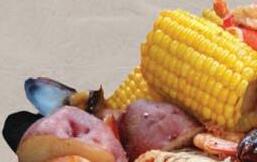






JULY 5 & 19




AUGUST 2, 16 & 30


This very popular joint in Langford has a lineup outside the door and a feeling of community, with staff and patrons calling each other by name and ordering their “usual.” It was a bit hard to get me through the door despite a recommendation, not just because of the crowd but because the name triggered, I will admit it, food snobbery in me.


The restaurant is, in fact, unabashedly basic Tex-Mex, but good Tex-Mex, with large portions and prices under $10, a price point rarely seen these days. The “staff favourites” icons did indeed help me target some good and filling lunches. Staff favourite number 1: the Rice and Bean Bowl for $9. This vegetarian dish is simple but feels rich because the black beans, soaked in vegetable stock, are tasty and plentiful. They sit on a bed of rice and are covered with a layer of guacamole, diced tomato,
drizzles of chipotle mayo and sour cream, and crunchy curls of thin, crisp tortilla chips.
Staff favourite number 2 is Pork Enchilada, which jumps up a level in complexity. This is made with a pork tinga, pork shoulder slowcooked with chipotle and mixed with diced chorizo. Choose between a side salad or rice and beans. The salad is topped with black beans, corn and cilantro, with a housemade sweet and tart cilantro dressing on the side. Again, this is a lot of food for only $9.50. The soft taco for $4.50 does not get the “staff favourite” stamp, but its two scoops of meat offer an opportunity to go crazy at the well-stocked sauce bar. I counted 21 bottles, all from Mexico and ranging from habanero to jalapeño to green pepper sauce. Yes, I blasted my palate and had fun doing it! Friendly, affordable and filling, Three Gringos fits the bill.











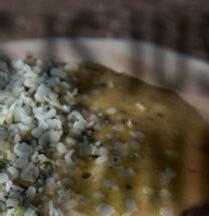


















Ten Victoria restaurants that have been serving us excellent meals for more than a decade.TEXT: JOSEPH BLAKE PHOTOGRAPHY: SHERRI MARTIN The Dining Room at Butchart Gardens Ruben Fontes Blue Poppy Restaurant Chef de Cuisine, Keith Tran Pastry Chef, Travis Hansen Executive Chef, Dave Lane Dining Room Manager and Sommelier, Anna Cameron (server)




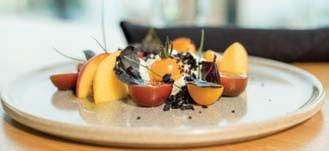


We are always in search of a food trend, the new chef on the scene, the latest hot spot. Too often we forget the value of restaurants that maintain quality and creativity for years. Here’s a collection of much-loved, Victoria businesses that have offered consistently excellent meals for more than a decade.
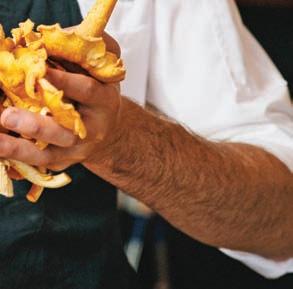


Ten years is a long time in the restaurant world. These 10 great, local dining spots are places to cherish.
Aura Waterfront Restaurant at Laurel Point Inn celebrated its 10th year in June. Executive chef Takashi Ito’s kitchen has won acclaim for its seasonal, Pacific Rim-inspired cuisine. His food is influenced by French and Italian cooking too, and his mentoring, team approach has recruited young international stars like Singapore-born restaurant chef Manpreet Sethi and pastry chef Kimberley Vy, an Alberta-bred innovator of Chinese, Vietnamese and Laotian heritage.
Aura’s 68-seat patio is a great summer perch from which to enjoy Victoria’s beautiful, busy harbour and a delicious west coast feast.

Blue Crab Seafood House at Coast Hotel is another consistently wonderful restaurant overlooking the harbour. Frommer’s International Guide describes Blue Crab as “the best seafood spot in Victoria,” and the kitchen’s fresh fish “Chalk It Up” daily specials continue to be exemplary.
House kimchi, house-cured sockeye and Blue Crab’s famous crab sampler and crab cakes have been highlights since the seafood house’s opening in 1991. Pan-seared rockfish with poached prawns and pan-roasted spring salmon with Dungeness crab tortellini are a pair of other personal favourites. Blue Crab is also known for great service and a Monday-Thursday afternoon happy hour with bargain-priced drinks and gorgeous waterfront views.
Brasserie L’ecole opened in 2002 by best friends chef Sean Brennan and sommelier Mark Morrison in a Government Street heritage building that housed migrant workers in the early 1900s. Brasserie’s kitchen was once a Chinese school, hence L’ecole Brasserie.
Chef Greg Ward’s consistent seasonal, locally sourced, classic French country-style cooking is matched by Morrison’s well-curated wine list and impeccable service, making this cozy bistro a perfect, romantic dinner date location. Reflecting on memories of Brasserie’s moules frites, French onion soup, crispy pork belly and spiced kale, endive salad with apples, bacon, hazelnuts and mustard/wine dressing, and perfect cuts of beef, I want to call and make a reservation ... but I can’t. A couple of years ago, Brasserie quit taking reservations, a move that dramatically helped their bottom line. The food and ambiance is so good I don’t mind lining up. 141 words
Construction began on Cafe Brio in 1996 and the Fort Street Italian restaurant opened on May 29, 1997. Greg Hays and Silvia Marcolini are the husband-and-wife team who own it, and the warm atmosphere and cucina rustica menu always feel like a visit to Silvia’s beloved Bella Italia. Brio’s walls are adorned with large paintings by local artists, the patio is a great spot to dine during warm evenings, and the two little rooms to either side of the front door are wonderful for intimate group meals. The six-course family-style menu is always a treat, and I especially enjoy chef Laurie Munn’s roast duck breast, rabbit fricasse and tenderloin.
“As for longevity,” Hays reflects, “it really comes from three things: passion, patience and perseverance. Be passionate about what you do. Have patience in the way you treat your staff and customers, and keep on keepin’ on! Silvia and I have always loved the process of running a restaurant. For me, it dates from my first job at The Keg in 1971, and for Silvia from 1982 when she started working with me at Herald Street Café Caffe. It is truly a great life.”
Their staff obviously agree: Amber Kitzler has been a server from Cafe Brio’s first day. Server Michael Simmons started shortly after. Chef Laurie Munn has been with Brio more than 12 years.
Breakfast 8am-Noon | Dinner 5:30pm to close
Shared plates, family-style

The Dining Room at Butchart Gardens is a too-little-known local gem that turns out more than 300 meals a night in the heritage family home during the busy tourist season, superlative meals featuring seasonal, house-made, locally sourced whenever possible, organically grown ingredients. The Dining Room also offers arguably the finest list of Vancouver Island-grown wines. Bob Parrotta, food service manager at Butchart Gardens for 16 years, manages more than 175 employees at peak season. “It’s important to note we have 14 Red Seal chefs in our kitchen and two sommeliers in our Dining Room, Parrotta explains. To accomplish this level of excellence during the busy June 15-September 15 and December 1-January 6 dinner offering, Parrotta and

his veteran staff have to share a vision and passion for their jobs. Their commitment is reflected in an extraordinary record of service. Many staff, such as executive chef Travis Hansen (26 years), pastry chef Kenneth Tran (28 years) and chef de partie Rajan Dillon (37 years), as well as managers on the service side, such as Lisa Durkin (32 years), have been with the restaurant for decades. “Butchart Gardens opened to the public back in the 1920s and is full of history. Even our employees become historic,” Parrotta jokes.
Il Terrazzo Ristorante opened in 1992 in a renovated brick building in Victoria’s Old Town. Originally the Colonial Metropole Hotel in 1890 (and later the Grand Central), the venerable hotel became a pawn shop, bottle depot and warehouse before the 1985 Grand Central Building renovation. Il Terrazzo’s location was the hotel’s bar and billiard room; the restaurant’s courtyard was originally many small buildings believed to have been brothels.
Now the busy restaurant serves up wood-fired pizza, house-made pasta dishes and other northern Italian favourites like a well-oiled machine. More than a dozen staff have been with Il Terrazzo for more than 10 years, a handful for more than 20.
On a recent visit, I enjoyed Funghi Arrosto (portobello mushrooms in a focaccia crumb and herb crust baked with garlic, prosciutto, sun-dried tomatoes, pine nuts and shaved parmigiano with tossed baby spinach, capers and balsamic vinaigrette) and cioppino brimming with local halibut, tuna, clams and prawns.
Terrazzo also offers lamb, chicken, beef and pork main dishes and an excellent international and B.C. wine list, lots of interesting cocktails, and pastry chef Samantha Lewis’s tasty versions of Italian treats like tiramisu, panna cotta and tartufi di cioccolato The restaurant is a model of consistent quality, good service and a warm, convivial atmosphere.
Oak Bay Marina Restaurant grew out of Bob Wright’s 1964 Sealand project and the Oak Bay Marina Group’s massive renovation in 1993. A fixture on the waterfront with sweeping views of the Cascade Mountains and Mount Baker, the Marina Restaurant features regional cuisine with special attention to local, sustainable, 100 percent certified Ocean Wise seafood.
Executive chef John Waller helped put Wickaninnish Inn’s highly regarded restaurant on the world’s culinary map before bringing his understated, respectful work with fresh seafood to Oak Bay Marina Restaurant. Recent meals featuring steamed clams, oysters from Out Landish Shellfish, and fresh butter-kissed halibut reminded me what a local treasure Waller and his veteran staff have created at this once-important First Nations clamming site. The Marina’s Sushi Bar is also one of the city’s best.
“We have multiple employees who have been with Marina Restaurant for much longer than 10 years,” explains manager Jason McMillan. “In front of house we have a server who has been with us almost 20 years, and in the back of house we have employees who have worked in our kitchen 10 years, 23 years and 26 years.”
Pacific Restaurant at Hotel Grand Pacific has overlooked the Inner Harbour since the hotel’s founding in the 1990s with the last major renovation in 2001. Executive chef Rick Choy has been leading the kitchen for 12 years producing meals he describes as “local west coast cuisine with Asian fusion features, quite international actually. We have hotel guests from all around the world,” Choy explains, “so we want to offer meals they’ll be familiar with.”
Choy enjoys his veteran staff (five people have more than a dozen years in the kitchen, the longest 16) “because I don’t have to spend time training them, and everyone shares the same focus.”
“For the summer months we’ve shifted our focus to the recently upgraded patios,” explains general manager Anthony McCauley. “We’ve revamped our well-curated wine list, added pitchers of cocktails to our small-bite menu, installed new fire pits and patio furniture, and lined up live music and DJ’s for Friday and Saturday nights. We’re planning another series of winemaker’s dinners too.”
I have warm memories of a previous winemaker’s dinner at Pacific Restaurant with Similkameen Valley’s Clos du Soleil Winery and delicious meals featuring chef Choy’s miso sable fish, braised short ribs, and Mentaiko butter pasta with prawns, prosciutto, arugula, yuzu dashi, shiso and parmigano parmesan.
Vista 18 is celebrating its 18th year atop Chateau Victoria. Renovated early this year, the restaurant offers spectacular, 18-storey views of downtown Victoria and beyond, tasty meals through-
bobsredmill.com

































Simple, honest, whole grain nutrition starts here.
out the day including a large, summer breakfast buffet, and live music in the Vista 18 Lounge on Friday and Saturday night featuring local musicians like Rhymer and Wells Duo and Steve Grebanier Guild.
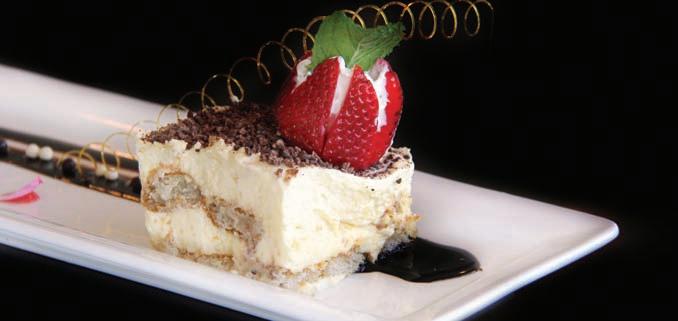
Executive chef Garret Garrett Schack, well-known to Victorians from his CHEK-TV show Cookin’ on the Coast, has been leading Vista 18’s kitchen since 2007. Award-winning chef de cuisine Mike Dunlop has been at the rooftop west coast grill and wine bar since 1998. Some of their much-loved menu items include seared ling cod cassoulet, smoked B.C. bison back ribs, and a seafood hot pot of local fish, mussels, prawns, Dungeness crab and crab dumplings in a tomato broth. Starters like Vista’s prosciutto-wrapped Vancouver Island rabbit loin, seared ole sole medallions and oysters on the half-shell are great too.
Zambri’s opened in a little storefront behind London Drugs on Yates in 1999. The brother-sister team of Peter and Jo Zambri moved their award-winning restaurant to its current location in the D’Ambrosio-designed Atrium in August 2011. The 85-seat room with patio seating on Yates, and more dining under the Atrium’s glass roof, offers chef Zambri’s traditional Italian fare an ambiance as warm and familial as the family’s venerable recipes and as romantic and urbane as the Theatre District lights outside. Zambri’s also has an excellent wine selection and friendly, knowledgeable service. From pizza and pasta dishes to crispy pork shoulder and Tuna Alla Livornese, Zambri’s kitchen produces consistently great Italian food.
“The secret to our longevity is not very romantic and is never the part of the business anyone wants to hear about. It’s tenacity,” Jo Zambri explains. “It’s the willingness to work harder physically than you could ever imagine and endure mentally everything that is thrown at you on a daily basis.
“The prettier side of it is having great partners who are always there, attracting and keeping great staff, and choosing amazing landlords,” Jo Zambri continues. “Maintaining consistency is probably one of the most important things about the restaurant business and one of the most difficult to manage. Right now we have Anthony Shannon back with us again. We hired him a month after we opened. And Jorga Melendez-Duke, who serves part-time, has worked with us on and off for 17 years ...”

A shared vision, passion, patience, tenacity, commitment, creativity and hard work. That’s what these 10 successful restaurants have in common. Day after day, night after night for more that a decade of great meals plus a lot of love and a little luck, that’s a recipe for real success.


250-360-1171

Having spent the lion’s share of my life writing about food from the heart of Canada’s cattle country, I didn’t think there was much more to learn about cooking a steak. Then a new cookbook crossed my desk, Steak Revolution by self-described steak fanatic Rob Firing. A bit of a steak savant according to his local butcher (Toronto’s meat mecca, Sanagan’s), Firing has learned to make the best of the “butcher cuts” of beef: the lesser-known skirt and hanger steaks, bavette, culotte and tri-tips. That’s part of the “revolution” Firing chronicles, a recognition of steak beyond the primal loin cuts, when a slower-growing, humanely raised, grass-fed animal is prized for every part in this nose-to-tail era.
Steak is having a bit of a moment in Victoria. Two of the newest dining spots in downtown specialize in steak—The Courtney Room at the Magnolia Hotel, and the re-imagined Veneto Kitchen + Bar in the Hotel Rialto. But even if steak isn’t the primary focus, most menus feature at least one beefy cut, whether it’s hanger steaks at Agrius, 32-oz. charcoal-grilled Tomahawk steaks at The Livet, or dryaged flat irons at Hanks.
In The Courtney Room’s kitchen, chef Sam Harris shows me a specialized Italian Arredo Inox Maturmeat® cooler holding an array of aging meats, from his own dry-cured salami and fat Yarrow Meadows duck breasts to whole primal cuts of Cache Creek Natural Beef. “This is my project,” says Harris, describing the program of aging, salting and fermenting meats for the restaurant, including steaks, which will mature for up to 60 days.
Steaks star on his menu, whether it’s the flat iron sliced with fries in the bistro or the à la carte meat menu in the dining room upstairs, where you can order a 6-oz. tenderloin ($45), 10-oz. dry-aged strip loin ($39) or 12-oz. rib eye
($55). “I’ll always have at least one butcher’s cut on the menu—a flat iron, bavette or hanger steak,” he says. “I love hanger steaks, though flat iron is definitely up there for its deep, rich, beefy flavour.”
Steak takes centre stage at the newly renovated Veneto Kitchen + Bar, too. Chef Tod Bosence settles into a booth in the sleek new dining room to explain why. “Our cocktail program has been so successful it was hard for our bartenders to keep up,” he says. Now the 98-seat space is devoted to dining, with a smaller bar next door. The new menu features American steakhouse classics, from chopped and wedge salads with gorgonzola dressing, to such as grilled sirloin, strip loin, filet mignon and rib eye steak, all sourced from Sysco’s premium Signature Butcher Block program. Steaks are offered in several sizes—from six- to 14-oz. portions ranging in price from $25 to $44—to reflect changing appetites and local demographics.
“I was inspired by the big American steak houses, but people in Victoria can’t afford a $60 or $80 steak,” says Bosence. “Millennials don’t want their father’s steakhouse—this is a kinder, gentler version.”
At Brasserie L’Ecole, where customers have been lining up for their steak-centric bistro menu since 2001, chef Greg Ward points to the chalkboard listing the day’s steak selection, from CAB (Certified Angus Beef) bavette and strip loin to AAA rib eye. Some is pasture-raised from Cache Creek and, when available, grass-fed island beef or Alberta Wagyu. This night, three of the steaks are CAB, an American-based brand of conventionally raised beef, with carcasses screened to meet 10 specific quality criteria for optimal tenderness and taste, he says.
“Lately we’ve been getting the Cache Creek Natural loins and sirloins, too,” he says. “They dry-age it for us for 40 days, which creates a more meaty flavour.” Today’s savvy customers are requesting dry-aged beef, grass-finished beef and uncommon cuts, whether a hanger steak or 40-oz. porterhouse to share, says Ward. “You couldn’t find a
bavette 15 years ago but now people ask for it.”
Take a trip to Italy for a thick Bistecca alla Fiorentina or visit the asadores of Spain’s Basque country, and you’ll find an array of steaks on the grill, beef from ancient breeds, pampered on wild pastures for 15 years before slaughter, and traditionally aged several months before sizzling over wood fires. Argentina, Japan, Brazil, France all have steak traditions featuring special cuts and unique cooking methods, whether it’s the bleu rare steak with frites in France, the pampered, fatty Wagyu on the plate in Tokyo or the charred skewers of pichana at a Brazilian churrascaria
But in North America, steak has been standardized. In most supermarkets, it’s a world of boneless, neatly trimmed strip loins, rib eyes and tenderloins, occasionally organic but mostly conventionally raised. Even big, thick T-bones and flank steaks are rare. But visit a specialty butcher shop, and there’s a wider selection.
“You have to read books and learn this kind of meat cutting—we’re all nerds about this,” says Mike Windle of The Village Butcher, where butchers break down sides of beef and pork in full view of customers.
Butchers should also tell you exactly how and where the beef was raised. The vast majority of beef in Canada is conventionally raised. Calves born in spring either graze on pasture (grass) or are sent to feedlots to be “finished” on grain or other high-calorie feed designed to fatten the animal for slaughter at 14-18 month. Unless it specifically says “raised without added steroids or hormones,” growthpromoting hormone implants were used—it’s the industry standard. Health Canada insures that any hormones or antibiotics remaining in the meat are at low levels, safe for human consumption, which conventional producers argue means all beef is essentially drug-free (and why, they say, “hormone” or “steroid-free” is a common misnomer).
 STEAK FRITES AT BRASSERIE L’ECOLE
STEAK FRITES AT BRASSERIE L’ECOLE
BRAD JOLLY'S FLANK MATAMBRE: from Steak Revolution(HarperCollinsCanada) Matambre, as far as I can tell, is an Argentine mash-up of “kill” (matar) and “hunger” (hambre), and it is sumptuous and substantial enough to do exactly that. It also refers to the Argentine cut of beef, like a flank but not exactly. In any case, I use a flank here because it’s easy to find—besides, that’s what my friend Brad used when he cooked it up on a surprise drop-in at my place. Like me, Brad is fond of big, deep flavours, and his matambre recipe does not disappoint. Serve with creamy polenta or mashed potatoes, and a little of the deepred braising broth ladled on top. Your dinner guests will leave immensely sated and eternally grateful. I know I was that night my epicurean friend dropped by.

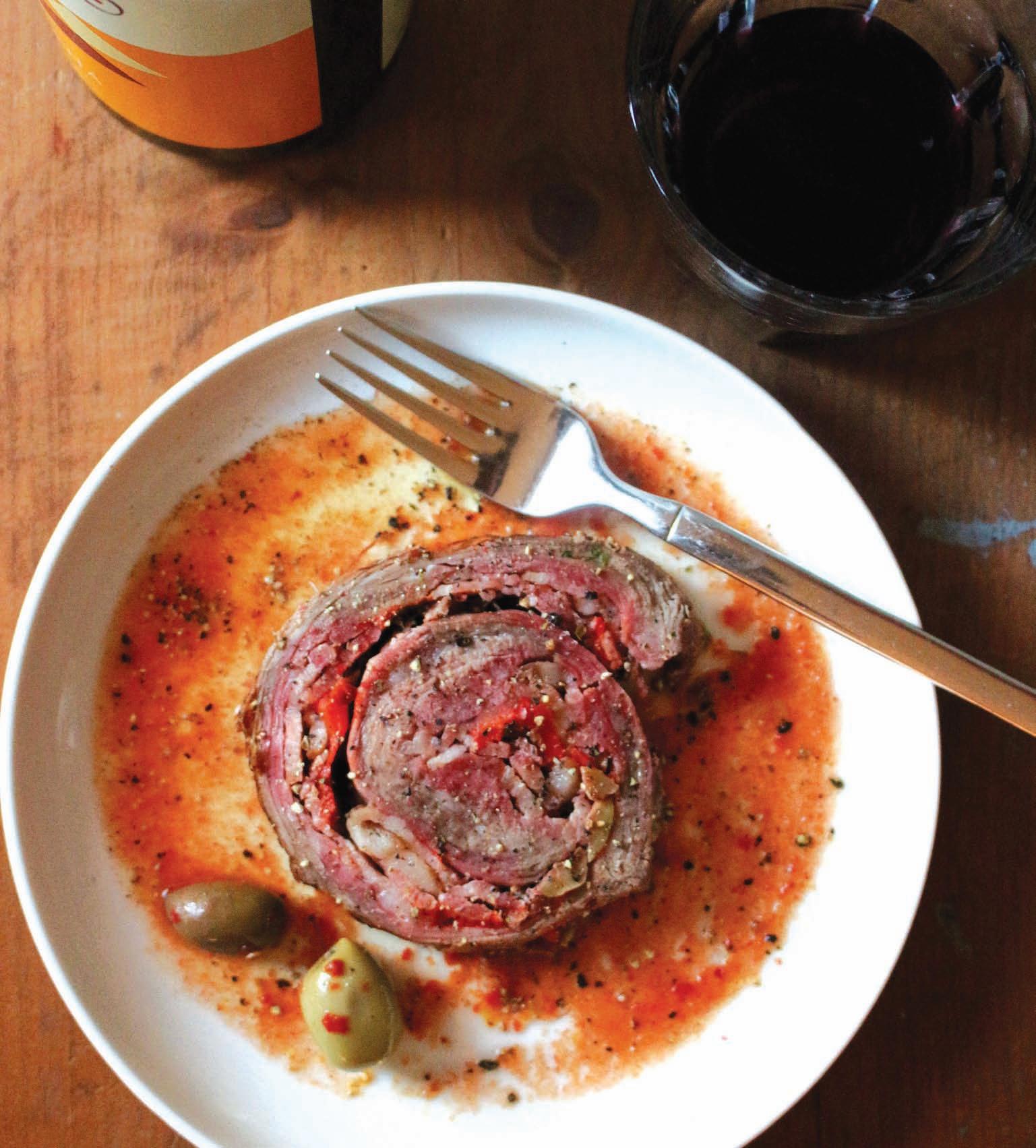
If the beef is certified organic, no antibiotics, pesticides or growth hormones may be used, and all feed must be organically grown, though most animals are fed and finished in feedlots like conventional beef. A lot of beef is “grass fed” at some point (another labelling ploy as it’s an unregulated term), so if you want beef from cattle that spent their entire lives on pastures, look for “grass finished.”
Village Butcher offers three “streams” of BC beef—pasture-raised from the Cranbrook area, certified organic from Blue Goose Cattle Company in the south Cariboo region, and grass-fed raised on Vancouver Island. Their premium dry-aged cuts are aged for 30 days in a special humidity-controlled cooler in the Oak Bay shop. Because they break down the local and organic carcasses themselves, they seam out the specialty steaks. The day I was there, several options were in the meat case, from skirt steak and culotte to thick strip loins and cowboy steaks on the bone. “People are still buying rib eye mostly,” says Windle, “but skirt steak and flank are popular, too.”
Farm + Field Butchers also brings in whole animals, many from Two Rivers Meats’ Cache Creek ranch or small islandbased farms producing grass-fed and finished beef. “We always have a variety of different steaks from high-end rib eye and tenderloin to less expensive cuts,” says ownerbutcher Rebecca Teskey. “We always have skirt steak, hanger, bavette and top sirloin. We’ll pull the flat iron from the shoulder; we harvest whatever we can.”
Teskey says only about five percent of Canadian beef is 100 percent grass-fed, but she looks for farms that keep their animals grazing on pasture for most of their lives, and finish them on barley or alfalfa for less than 12 weeks.
“There’s a lot of misinformation about how beef is raised. You can only know by asking,” she says, adding their beef is aged for 28 days. “If you want good beef, you’ve got to open your wallet. The only way to produce cheap beef is with steroids and antibiotics. The beef we buy is more than double the price, but the flavour and quality is so much better than the commodity stuff.”
It’s “a myth,” she says, that butcher cuts are cheap. “Beef is expensive across the board,” says Teskey. “Flank steak is still $20 a kilo, even high-quality ground beef is expensive. It’s true of the entire food system. Anything industrialized is cheaper, but I think we need to eat less meat, and choose better.”
Other butchers are offering beef from their own suppliers and cutting steaks on site, too. At Slater’s Meats, butcher and co-owner Geoff Martin says steaks are cut to order from Alberta AAA beef. It’s conventionally raised, but “it’s all about the way we age it and cut it,” Martin says.
“All of the beef in the case is wet-aged, a minimum of 28 days, but we also get Vintage 67 beef, dry-aged from the slaughter house for 35 days,” he says, adding some customers special-order grass-fed beef or even bison.
For Wali Popal, owner of the new Bold Butchery + Grill, all of the meat he sells is certified Halal, catering to the city’s Muslim population. Halal meats must be slaughtered in the Halal method (by hand by a Muslim man, in a low-stress environment). Popal offers big chunks of sirloin tip stew beef for kebabs, flank, rib eye, rib and striploin steaks, all raised without steroids and hormones in BC, and slaughtered in the province’s only Halal facility. “It does add to the cost, about 10-25 percent,” he says, “but Halal is a sustainable way of raising animals. And it does affect the quality and tenderness of the meat.”
While the best way to understand the beef you’re buying is to talk to a butcher you trust, there are so many options, you’ll need to do your homework first.
Beef is graded according to its levels of intramuscular fat or marbling, age and other carcass specifications—Prime and AAA being the highest grade with the most fat. Only two percent of Canadian beef reaches Prime grade, with up to 50 percent graded AAA. There are also branded premium beef programs such as Certified Angus Beef, Angus Pride, Butcher Block Reserve Angus and Sterling Silver. This beef is from conventionally raised cattle that’s graded in the processing plants after slaughter.
Because it is never fattened in a feedlot, grass-finished beef is leaner, darker in colour with a beefier flavour and usually grades lower. Aging is another variable in the taste and tenderness equation. Supermarket steak is usually “wet aged” (sealed in plastic) and often sold within days of slaughter. Dryaged meat is hung in a temperature- and humiditycontrolled cooler (usually for 21-28 days but longer for some premium beef). The slow decomposition tenderizes the meat and imparts an aged flavour but also increases the cost significantly as the meat loses moisture and must be trimmed before cooking
Today’s industrial model of beef production in feedlots may produce the cheapest protein, but there are other issues, from the humane treatment of animals to our air, water and climate. Scientists point to beef production as a major contributor to climate change. Replacing 25 percent of your beef consumption with lower carbon meats (like chicken) would reduce carbon emissions system wide by six percent according to a new study evaluating the entire food industry’s impact on global warming.
But author Rob Firing says the solution is not that clear cut, pointing to Nicolette Hahn Niman’s 2014 book, Defending Beef. Niman, an environmental lawyer turned California cattle rancher argues that, when properly managed on pasture, grazing cattle act like the wild bison before them, actually helping to maintain the grassland ecosystems, enhance biodiversity and mitigate climate change by trapping carbon in the soil. Firing agrees, adding that replacing factory farms with small-scale beef production and grass feeding is a growing global trend among “enlightened ranchers.”
“The footprint for cows raised properly can provide environmental services to a surprising level,” he says.
Eating less, but better, beef is a better answer, he says, because a sizzling slab of steak is the ultimate indulgence. “It’s hardwired somewhere in our ancestral past. It harkens back to the hunter-gatherer of the Great Plains, the prestige of coming back with a big animal, and the celebration,” says Firing of our ongoing love affair with beef. “It meant a lot. It saved your life and was incredibly nutritious.
“It all comes down to the senses, the way a steak cooks, especially on an open fire, fat dripping and charring, the scent and sound and incredible umami and smoky flavour,” he adds.
WHILE THE BEST WAY TO UNDERSTAND THE BEEF YOU’RE BUYING IS TO TALK TO A BUTCHER YOU TRUST, THERE ARE SO MANY OPTIONS, YOU’LL NEED TO DO YOUR HOMEWORK FIRST.
Most people think they know how to cook a steak—a good sear on a hot barbecue, and voila! Steak dinner.
Not so fast. Is there a better way to coax the best from your beef?
As Firing reveals in Steak Revolution, there’s a learning curve, especially when it comes to the leaner butcher’s cuts. Most of these steaks should never be cooked past rare to medium rare (120-125˚F before resting), then must be sliced across the grain for tender eating.
Firing outlines his favourite techniques for specific cuts, whether it’s grilled, fried in a cast iron pan (for thinner steaks) or, for larger, thicker steaks, “reverse-seared,” that is, first cooked slowly (in a low 180-225˚F oven) until nearly done (about 115˚F internal), before a finishing sear in a hot pan.
We asked local butchers and chefs about the steak they like to cook, and how:
Rebecca Teskey, Farm + Field Butcher:
“Hanger steak is one of my favourites. I love the rich, minerally flavour—but I’ll often fry a skirt steak in a cast iron pan. Just salt it, sear it and cut it across the grain.”
Chef Sam Harris, The Courtney Room:
“I love the deep beefy flavour of flat iron. It’s leaner than a strip loin, so I sear it in a cast iron pan, add butter, let it brown and baste. Let it rest and slice properly, across the grain, to serve.”
Wali Popal, Bold Butchery + Grill:
“My favourite is rib eye and my mantra is low and slow. Season with salt, pepper, coriander, paprika, seal in a sous-vide bag, cook for 1.5 hours at 128˚F, then rest seven minutes, dry and sear in a very hot cast iron pan, basting with garlic butter.”
Mike Windle, Village Butcher:
“My favourite changes from day to day but I love hanger steak. I do it in a cast iron pan and baste it with brown butter and sage leaves.”
Geoff Martin, Slater’s Meats:
“Seems like a cliché, but rib eye for me, from the first three cuts off the shoulder. I use Barberian’s Steak seasoning. Leave the steak out for one to two hours, season 15 minutes before cooking, get the grill really hot to sear both sides, then turn down to medium, 350˚F or so, and cook indirect to medium rare, 125˚-130˚ internal. Let it rest 5-10 minutes to let the juices settle.”
Chef Tod Bosence, Veneto Kitchen + Bar:
“My favourite is a New York Strip, coated with fresh cracked peppercorns, seared in a cast iron pan, and served with duck-fat-roasted fingerling potatoes.”
Chef Greg Ward, Brasserie L’Ecole:
“A bone-in rib steak, super thick, about three inches. Just season with salt and pepper, cook hot for 30-40 minutes, then rest for 10-20 minutes and carve.”

t
Our positive screening tools can identify companies that meet stringent Environmental, Social and Corporate Governance (ESG) standards so you can be as selective about your investments as you are with your nutrition.
www.blueherongroup.ca 250-361-2284 | blueheronadvisorygroup@cibc.ca
Neil Chappell and Graham Isenegger are Investment Advisors and Portfolio Managers with the Blue Heron Advisory Group of CIBC Wood Gundy in Victoria BC. CIBC Wood Gundy is a division of CIBC World Markets Inc., a subsidiary of CIBC and a Member of the Canadian Investor Protection Fund and Investment Industry Regulatory Organization of Canada. CIBC Private Wealth Management consists of services provided by CIBC and certain of its subsidiaries, including CIBC Wood Gundy, a division of CIBC World Markets Inc. “CIBC Private Wealth Management” is a registered trademark of CIBC, used under license. “Wood Gundy” is a registered trademark of CIBC World Markets Inc. If you are currently a CIBC Wood Gundy client, please contact your Investment Advisor. Past performance may not be repeated and is not indicative of future results.







Slow down on Salt Spring. Cook your dinner in your cottage on the lake. Walk the beautiful wooded trails or visit the many independent boutiques, galleries and cafés in Ganges. Take in the market on Saturday. Cross the sea to our beautiful island. It’s closer than you think.


































he fresh shrimp season in the Pacific Northwest was reason for celebration as spring brought harvests of wild spot and sidestripe prawns to restaurant menus and fish retailers’ shelves. Alas, the season, as short as it is sweet, is now over. For consumers, farmed shrimp is a year-round alternative, though one often fraught with anxiety about the conditions the shrimp are grown in and the environmental impact of open-net pens, not to mention the exotic cocktail of antibiotics the shrimp may be consuming.
Globally, aquaculture accounts for half of all seafood produced for human consumption, and by 2030, that number will grow to about two-thirds, according to the UN’s Food and Agriculture Organization. In Canada, we eat far more farmed seafood than wild, and shrimp is very high on the list of most-favoured seafoods. Despite the growing demand among consumers to know what they’re eating, where it’s from and how it was produced, the origins of imported farmed shrimp may not be as clear-cut as we’d like.
Happily for the local market, there is a brand-new solution—farmed shrimp that are as tender and luscious as their wild cousins, and environmentally kind enough to earn kudos from both Ocean Wise and the David Suzuki Foundation. The newly operational Berezan Shrimp Company, based in Langley, has been in active production just since early April, though planning and construction have been underway since 2014. In this initial, pilot stage, the yield is expected to be almost 2,000 kilograms a week or 100 metric tonnes a year. That’s just a drop in the bucket compared to the 50,000 tonnes of farmed shrimp imported into Canada in 2017. Nevertheless, it’s a promising start. The company hopes that yield will rise to about 20,000 metric tonnes by 2024.
The bucolic landscape of south Langley, about 25 km inland from the ocean, seems an unlikely setting for such an innovative aquaculture enterprise. The sprawling, windowless metal shell that houses the shrimp farm holds little outward promise of spa-like conditions, though general manager Warren Douglas delights in describing the facility as a “shrimp spa.” That description seems more than apt when you venture beyond the utilitarian office and enter the room holding the giant tanks of shrimp. The humid, warm environment carries a faint whiff of briny sea water, more reminiscent of Thailand than the Lower Mainland.
The tiers of more than a hundred tanks contain about four million Pacific white-legged shrimp, native to Central and South America. It takes about four months from the time they’re imported as hatchlings from a fishery in Florida to maturity under carefully monitored conditions. The tiered system produces a greater yield per cubic metre of water than open pond farming. And that water is a critical part of
the operation. An artesian well provides the fresh water that is supplemented to replicate ideal salinity. Vegetablebased feed and small amounts of fishmeal are pumped through the tanks continuously. A state-of-the-art recirculating aquaculture system (RAS) allows the operation to clean, detoxify and re-use almost 100 percent of the water. Total water consumption is only about 11 litres per minute. Eventually, according to Douglas, organic waste may be packaged and sold as fertilizer.
This is, indeed, a very sophisticated operation, unique in size, scope and configuration. Other shrimp farms, Douglas says, are typically built on open hectares, with little or no biosecurity, and uncontrolled water and climate condi-
THE BUCOLIC LANDSCAPE OF SOUTH LANGLEY, ABOUT 25 KM INLAND FROM THE OCEAN, SEEMS AN UNLIKELY SETTING FOR SUCH AN INNOVATIVE AQUACULTURE ENTERPRISE. THE SPRAWLING, WINDOWLESS METAL SHELL THAT HOUSES THE SHRIMP FARM HOLDS LITTLE OUTWARD PROMISE OF SPA-LIKE CONDITIONS, THOUGH GENERAL MANAGER WARREN DOUGLAS DELIGHTS IN DESCRIBING THE FACILITY AS A “SHRIMP SPA.” THAT DESCRIPTION SEEMS MORE THAN APT WHEN YOU VENTURE BEYOND THE UTILITARIAN OFFICE AND ENTER THE ROOM HOLDING THE GIANT TANKS OF SHRIMP. THE HUMID, WARM ENVIRONMENT CARRIES A FAINT WHIFF OF BRINY SEA WATER, MORE REMINISCENT OF THAILAND THAN THE LOWER MAINLAND.
tions. So how did sleepy Langley become home to this high-tech venture? The Langley-based Berezan family have kept a low profile while developing a small empire of liquor stores, resorts, specialty liquors and more throughout North America. A few years ago, on a business trip to Texas, they were introduced to the idea of a self-contained aquaculture system, and to Dr. Addison Lawrence, a leading expert on shrimp and the lead scientist in charge of Texas A&M University’s AgriLife Research Program. The Berezans saw a good business opportunity that offered excellent growth potential along with a socially responsible methodology. Dr. Lawrence, now Chief Science Officer for Berezan Shrimp Company, designed the facility using his patented raceway system—the stacked, contained pools that can accelerate shrimp production while controlling all elements of the animals’ environment.
As with any innovative enterprise, there were challenges and setbacks in the early stages. The team of 11 scientists— biologists and agricultural experts—who have been monitoring the operation from its beginnings, had to
troubleshoot the critical elements of water temperature, nutrition and salination among other considerations. But eventually they got it right, and Berezan sent out its first shipment of farmed shrimp in early April.
Of course, the ultimate arbiter of the system’s success is the consumer. Among the best and fastest ways to reach that consumer was through One Fish Two Fish, a well-loved seafood shop in downtown Langley, now celebrating its 20th anniversary in a spacious, newly renovated location on the Fraser Highway. According to owner Heather Jenkins, people are warming up to Berezan’s product.
“People tend to be a bit nervous about farmed shrimp,” Jenkins says, “so part of my job is to educate them on the difference between shrimp farms that are done poorly, and those that are done right. Berezan’s have really thought things through. The flavour is fantastic.”
Jenkins prides herself on being able to supply both the education and the best seafood products available. “I’m always asking ‘is it healthy?’, ‘does it damage the environment?’” she says. “My customers are really focused on where a product comes from, and how it’s processed.”
So far, Jenkins reports that her shop goes through about 20 pounds of Berezan shrimp a week, though she sees demand building. “Once customers try them, they come back for more.” At $25 a pound for head-on shrimp, and $39 a pound for head-off, she has priced them competitively with spot prawns and giant Mexican prawns. At a count of 26 to 30 per pound (head on) the fresh shrimp are smaller and more fiddly to clean, but the freshly harvested critters offer crisp, firm flesh and succulent sweetness, more than ample compensation.
So far, distribution of Berezan shrimp is fairly limited, but the markets are becoming more plentiful. Albion Fisheries is the supplier for Vancouver Island and the mainland (restaurants and stores—ask for the Vancouver Island representative). In the Metro Vancouver area, the shrimp are available at One Fish Two Fish in Langley, and Bruce’s Country Market in Maple Ridge, as well as at Granville Market. In Victoria, the shrimp are available at Market on Yates and Market on Millstream. Meanwhile, more and more chefs are adding these briny gems to their menus. Look for them at Bacchus Bistro in Langley, Restaurant 62 in Abbotsford and Hawksworth in Vancouver.
Though still brand new to the market, Berezan shrimp are earning accolades from high places. Marc Blouin of Albion Fisheries says, “In over 34 years in the seafood business, I have yet to taste a shrimp as sweet and tender as these.” TV food personality and chef Ned Bell echoes the sentiment: “I thank Berezan Shrimp for shooting high, growing these premium shrimp in a fully closed and sustainable way.”
FOR VICTORIA-AREA RETAILERS AND RESTAURANTS CONTACT KATRINA COLLEY OF ALBION FISHERIES


The Victoria Public Market has become an icon for our city’s cultural culinary landscape. Housed in the Hudson Building in the newly appointed Hudson District, Victoria’s only food hall and permanent public market is often mischaracterized as The Hudson Market. Not so – This is The Victoria Public Market, and it’s time to take a deeper dive into how to maximize your, shopping, eating, and browsing at what Victoria Public Market GM, Jaymie Humber will remind you is “not just a lunch spot.”
As Victorian’s, our previous point of reference for public markets were either Granville Market or Pike Place Market. We are a tinier and more curated outfit, are we not? And as such, we need to pay attention to the details of our small yet irreverent food hall. The definition of a public market is as follows: “A Public Market is a year-round, carefully crafted, intentional, and diverse medley of owner-operated shops, stalls and/or “daytables”. I would add to that, that a public market should be reflective of the needs and desires of the community it serves and should contribute to the cultural lifestyle of the neighbouhood it is in.
In our growing downtown core, increasingly populated by a younger, savvier and busier generation, there is both a need and desire for diverse food choices and innovative options for dining out. The Victoria Public Market offers a variety of ways to experience some of the best food Victoria has to offer, sans reservations. Take for example, Victoria Pie Company’s Pie of the Month Club (sweeter words were never spoken) – that’s right! Get a pie like clockwork every month (or 6 or 3 if that’s how you want it) on a subscription basis. Roast Meat and Sandwich
Shop offers a picnic basket that can be taken to the rooftop, the park, or the waterfront to enjoy Victoria the way it was intended – under a sunny sky with the consistent threat of rain (it makes life exciting, right?) The Very Good Butchers have turned the idea of BBQ on its head by offering plant-based options for your favourite meat dishes. Instead of leaving your vegan friends out in the cold where their only options at your summer BBQ is whatever roughage they can gather, you can now offer them a delicious cruelty-free bean patty, loaded with organic veggies and spices.
The Victoria Public Market is a one stop destination for all of your food needs. Yes, popping by or lunch is one way to use the market but the venue should also be thought of as the hub for local eats and treats that supports the vibrancy and creative expression of our robust local food scene. West Coast Pantry will fill your cupboards with the best local options from our hardy community of artisan producers; Sutra takes the thinking out of dinner and adds some spice with its curry dinners ready to go and the much anticipated Accio Kitchen take out spot set to open July will change the game of take-away and dining restaurant-style at home.
Year round The Victoria Public Market serves as the core of the Victoria food scene. It brings the community together through food, community events, and steadfast support of local small business. As our city continues to grow, so will out culinary landscape and can consistently rely on The Victoria Public Market to showcase the best this city has to offer. —Jill Van Gyn

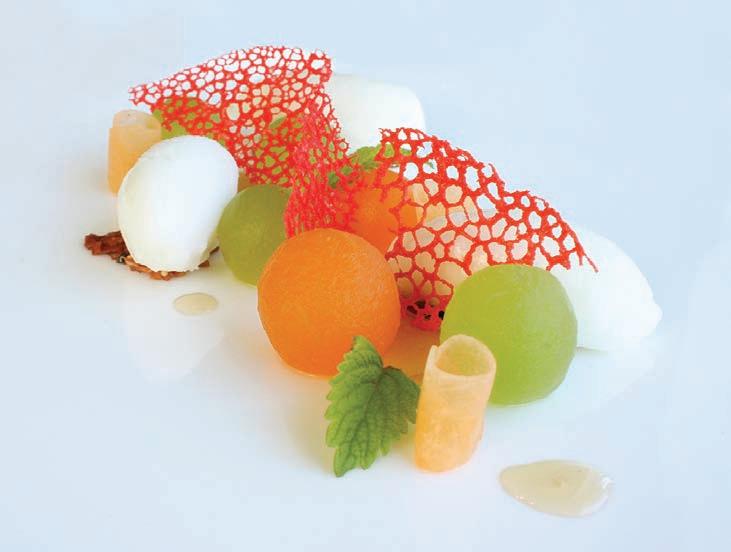






















I continue to be in awe of this time of year. Every winter, I forget what it’s like to wake up to warmer days and brighter skies, garden beds full of fresh flowers and good things to eat. The abundance. (I talk about that a lot, and for good reason.) The change of wardrobe and appetites and the peaceful mindset that comes with sun and heat and longer days. We’ve moved through the brightness of spring, with its new growth and green-ness and into the deep warm colours of summer. Doors flung open, the buzz of bees, everything on the grill. This simple, almost-foolproof recipe is good in the oven or on the grill and is a no-fuss entrée for solo meals, family gatherings or dinner parties al fresco. You can use whatever fish you like, the freshest herbs from the garden and any citrus or vegetable you have on hand.
We don’t get a long summer here on the West Coast so it’s important to indulge and revel in the days we have. Right now. These are the days. Enjoy them. Serves 4.
Preheat oven to 425°F (rack in centre) and cut 4 large pieces of parchment (big enough to double wrap each bundle in). Set the table with lemon wedges and minced chives.
3 Tbsp salted butter, softened
2 Tbsp fresh herbs, minced (dill, basil, chives, fennel frond, parsley—any of these work)
Zest of one lemon, finely minced
1 tsp fresh lemon juice
¼ tsp salt
4 6-oz skinless, boneless fillets of halibut
12 thin spears of asparagus, washed and trimmed
12 very thin slices of red onion
2 Tbsp capers, drained
8 thinly sliced lemon wheels
2 Tbsp chives, finely chopped Salt and pepper
In a small bowl, combine butter, herbs, lemon zest, lemon juice and salt. Mix well and set aside.
Set a fillet of halibut in the centre of one piece of parchment. Set 3 asparagus spears snugly next to the fish. Top fish with 3 slices red onion, a quarter of the capers, 2 lemon wheels and a sprinkling of chives. Dab the top with a quarter of the butter mixture. Season generously with salt and pepper.
Pull two sides of the parchment up and over the ingredients, bringing the edges together at the top, then folding over repeatedly, until the parchment is snug against the fish. Twist the remaining ends and tuck underneath the package so it is a tight, neat bundle. You want to keep the package sealed well so no steam escapes. Repeat this process with the remaining 3 bundles.
Set all 4 bundles on a sheet pan and place in the oven. The amount of time it will take to cook your fish will vary, depending on its thickness. Start with about 12 minutes, gently unfold a bundle to check doneness and return to oven for up to 20 minutes if necessary. Your fish is cooked when it is just opaque and flakes easily. The internal temperature should be around 140°F.
Remove pan from oven and let sit for 5 minutes. Place folded packages on 4 plates, letting your guests unfold at the table and take in the gorgeous steam that comes from inside.
Serve with a tossed green salad, a pot of rice or steamed baby potatoes.




ACCORDING TO BUZZ-NOTING MEDIA OUTLETS like the Huffington Post, “going vegan” is poised to be the biggest food trend of 2018 and beyond. The rise of plant-based eating is, indeed, evident and widespread. Internet searches for “vegan” tripled from 2016 to 2017, and consumers bought 2.7 times more plant-based products online in 2017 than they did in 2016. What’s more, even many “carnivore-friendly” restaurants are incorporating dedicated vegan menus in an attempt to meet the rising demand for plant-based fare. If you’re ready to jump on the vegan bandwagon, there is perhaps no better time to do so than during these dog days of summer, when fresh produce is at its “just-ripe” best. However, you need to keep in mind that a healthy vegan diet is about more than lettuce and berries. A meatless diet CAN be healthy, but according to the Academy of Nutrition and Dietetics, vegans need to make sure they’re getting enough of the following substances to ensure optimum health. Let’s take a look at the nutrients vegans need to pay attention to.
IRON





Unfortunately, the most abundant and absorbable sources of iron are found in animal products— but that doesn’t mean vegans are doomed to fall short of this mighty mineral. Good plant sources of iron include tofu, legumes, dried apricots, spirulina, wheat, molasses, pumpkin seeds and ironfortified cereals. Consuming these foods with Vitamin C-rich foods or a Vitamin C supplement will enhance the absorption of iron.
PROTEIN
While getting enough protein is easy to do when you eat meat and dairy, it’s more problematic when you’re vegan, particularly if you rely on processed vegan foods or focus solely on produce at mealtimes. The solution lies in making sure you’re incorporating a wide variety of protein-rich plant foods in your regimen. Your best bets include legumes, seeds, nuts, sprouted whole grains and plantbased protein powders.
Calcium
Since vegans forego dairy, they need to include plenty of calcium-rich plant foods in their diet. Good sources include dark leafy greens, amaranth, almonds, tofu, black-strap molasses and fortified nut and soy milks.
Vitamin D


Carnivores can get dietary Vitamin D from fish and dairy products—but vegans have to rely on fortified products and/or supplements to meet their daily needs. Talk to your health care professional for recommended dosages and look for a quality Vitamin D3 supplement at your local health foods store.


Vitamin B12
The only truly reliable vegan sources of B12 are foods fortified with the vitamin (some plant-based milks, fortified cereals) and supplements. While there are small amounts of the vitamin in spirulina and nutritional yeast, they’re not enough to ward off deficiencies. I recommend vegans take a daily 5 microgram supplement—but it’s best to check with your primary care physician to discuss your personal needs.
Omega-3 Fats

Who needs fish? Flaxseed meal and oil, walnuts, chia seeds and omega-3 supplements derived from algae are all excellent plant-based sources of these heart-healthy fats.

Zinc

While it’s true that meat is an excellent source of this mineral, it can also be found in pumpkin seeds, legumes, oats, wheat germ and nutritional yeast.
When a vegan diet is well-planned, it certainly can provide some impressive health benefits, including: lower cholesterol levels; a reduced risk for Type 2 diabetes and certain cancers; lower blood pressure and more. The key is focusing on whole foods teeming with the above nutrients, not processed vegan foods like tofu dogs!

No need to swear off meat to appreciate the flavours of this vegetarian-friendly meal inspired by the cuisine of the Middle East. The thick and tangy labneh, a salted and drained creamy yogurt cheese, is a staple of the region. It is often served as a dip with lots of olive oil and a sprinkle of zaatar. The beautiful roasted nut topping delivers crunch and nutrition. To prepare, spread labneh generously onto each grilled aubergine, top with the roasted nuts and garnish with herbs and chili flakes. Serve warm with a side of the Mediterranean-style salad, you’re going to want enough for leftovers the next day.






LABNEH





3 cups yogurt
1 tsp sea salt

Combine yogurt and sea salt. Lay 3 sheets of cheesecloth, one on top of the other, over a sieve set on top of a bowl and pour the salted yogurt on top. Wrap the cheesecloth around the yogurt and leave it to drain at least 12 hours or overnight at room temperature. Once drained of its liquid, it should be like a thick, creamy paste with a sour taste and a hint of salt. Labneh can be stored in the fridge for more than a week. Makes 1 ½ cup.
GRILLED AUBERGINES
4 baby aubergines, sliced in half, stems kept on Olive oil
Zaatar spice blend
Sea salt and ground black pepper
Slice aubergines in half and score the flesh. Brush generously with olive oil, sprinkle with zaatar, salt and pepper. Oil grill or grill-pan and heat to medium-high. Once hot, place aubergines on the grill, flesh side down. Grill for 4 to 5 minutes on each side, until golden brown and soft to touch. Makes 4-6 servings.
ROASTED NUT TOPPING
2 cups raw pecans or walnuts, chopped
2 Tbsp coconut aminos*
1 Tbsp zaatar

1 Tbsp olive oil



½ red onion, chopped
2 garlic cloves, chopped
Sea salt and ground black pepper
In a small frying pan, on medium-low heat, toast the nuts with ½ Tbsp of oil, coconut aminos and zaatar for about
5-8 minutes. Remove from heat and place aside in a bowl. Using the same frying pan over medium heat, fry the onion in the remaining oil for 6 min. Add the garlic, season with salt and pepper and continue cooking one more minute. Return the nuts to the pan and mix well. Remove from the heat. Makes 2 ½ cups.
*Coconut aminos is a great soy- and gluten-free substitute for soya sauce made of fermented coconut sap and sea salt.

GARNISH

¼ cup fresh cilantro, roughly chopped
¼ cup parsley, roughly chopped Chili flakes, to taste
MEDITERRANEAN STYLE SALAD
1 cup pearl couscous (Israeli couscous), cooked
1 cup cherry tomatoes halves
4 mini cucumbers, sliced
½ red onion, finely sliced
2 cups diced red, yellow and orange bell peppers
½ cup chopped cilantro
¼ cup chopped mint
2 Tbsp lemon juice




2 Tbsp olive oil
Combine all ingredients and let it rest 5 to 10 minutes before serving.
Shish kebabs and skewers, brochettes and satays, paletas and pinchos—no matter what you call them, food prepared and served on sticks are global treats. They’re the right choice for summer outdoor dining, a versatile and easy vehicle for cooking and eating, whether eaten right off the skewer or shuffled into a pita, tortilla or grilled bread. They are the food of carnivals, outdoor fairs and food trucks—think corndogs and cotton candy—and a simple solution when an elaborate meal is out of reach.

Cooking food over fire, wood, charcoal or on a grill is a timeless, primitive technique. It can
be as simple as a campfire or hibachi, or as elaborate as a live-fire luxury barbecue. But the essence is still the same.
Some of my fondest food memories centre on devouring something tasty off a skewer: hot dogs and marshmallows over a beach fire; anticucho, or beef hearts, enjoyed at a roadside stand while backpacking in Peru; chicken yakitori at a long-gone Japanese takeout joint on Robson Street; or shrimp skewers hot off the embers at a makeshift Mexican beach standin-the-sand. All were so simple, and so delicious, with that necessary tinge of char.
Shish kebab, or kabob, is of Turkish origin. The word shish means sword or skewer, and the most famous, adana, is a traditional mix of spicy minced beef or lamb molded onto flat metal skewers and cooked over hot coals. With the availability of ingredients such as sumac, harissa and ground coriander and cumin, an improvised version is doable at a moment’s notice.
Another molded and ingenious technique hails from Vietnam. Shrimp paste is wrapped around a piece of edible sugarcane (chao tom), adding a bit of sweetness. It’s first steamed, then grilled and enjoyed with fresh lettuce, herbs and a nuoc cham dipping sauce.

The long, thin bamboo skewers are widely used today for kebabs of all inventions, but aficionados may want to consider buying quality, reusable stainless steel skewers for home use. Other sticks include whittled wood or sturdy rosemary branches for a rustic feel (they also lend an aromatic touch to the finish product).






My favourite skewers are the seven-inch flat or paddle-ended bamboo ones. They look great speared with anything from grilled meats, marinated prawns or vegetables. For any bamboo or dried wood skewers, soaking them in water for a couple of hours before spearing cuts down on flare-ups on the grill. Also, remember to keep the end of the skewer free of food and out of the line of fire, so you can easily turn them.
Skewers without the fire also work perfectly for raw or cooked and served-cold appetizers. I had the most delicious salad skewer recently that spiked chunks of iceberg lettuce with avocado and radishes drizzled with a blue cheese dressing over top—wonderful! And fruit kebabs make a popular summer brunch starter served with a poppyseed-yogurt dip. An elegant appetizer that always impresses guests is mini bocconcini alternated with cherry tomatoes and basil leaves and drizzled with pesto. Marinated prawns, cooked and chilled, are a no-brainer for a platter of skewers, especially when using the seven-inch variety. Toothpicks are the essential spike for any tray of hors d’oeuvres, just don’t try putting them on the grill! Party fare of the 1950s and 1960s would have been bereft without them—angels on horseback, anyone?—and they feature prominently spearing Spanish pinchos, those tiny snacks of infinite iterations.
When constructing kebabs, chunky is best. Remember, meat will shrink on the grill, and additions such as onions or peppers need to remain on the stick, not fall off. The same goes for vegetable-based skewers, with an added tip. Make sure the vegetables all take the same amount of time to cook. If you’re thinking of added a nugget potato to the mix, try parcooking the spud beforehand. For chicken, I like to use long pieces cut off the breast and weave them along the skewer for maximum hold. Fish should be firm-flesh varieties such as snapper, halibut, salmon or tuna that hold their shape under fire. For seafood, scallops, prawns and shrimp are ideal, skewered whole. Take care not to squish ingredients tightly together; a little breathing room allows even cooking throughout. And for best results, allow your kebabs or skewers to come up to room temperature before putting them on the grill.
For flavour enhancements, get ready to cook the world. Sure, salt and pepper work just fine—or salt and lemon—but why not transport ingredients with marinades, sauces and dips?
For example, satay or sate is a traditional favourite of Southeast Asia. Meat, usually chicken woven on the skewer as I described, is grilled and served with a moreish peanut sauce of peanut butter, coconut milk, chilies and lime juice. It makes for great party fare. I’m amazed there isn’t a food truck close by solely devoted to this delicious treat. For yakitori, a sauce of soy, mirin, sake, sugar and water is cooked and reduced until it’s thick and glossy. The sweet and savoury sauce is then brushed over skewered chicken thigh meat and scallions until it’s cooked and caramelized. In Japan, yakitori is cooked over a special charcoal, binchotan, which burns at a high temperature and holds its heat for a long time. (There’s a great episode of David Chang’s Ugly Delicious Netflix series that highlights the charcoal and grilling technique. It should also be noted that the skewers used are the seven-inch version, known as teppogushi).

My favourite marinade, which I use on chunked lamb sirloin, is a thrown-together mix of minced garlic, chopped fresh rosemary, salt, lime juice and a few healthy glugs of olive oil. The meat is so tender and the marinade creates an aroma and flavour to die for.
Marinades not only add flavour but promote browning, or caramelization, and crispness. Soy sauce makes a great base for a marinade along with ginger, garlic and a hit of sugar and lime juice. The acid doesn’t necessarily tenderize the meat but balances the sweetness. For something Mexican-esque, chopped chipotle en adobo with lime juice, garlic and a bit of honey does wonders on flank steak, finished with chopped cilantro before serving.
Besides onions and peppers to round out a skewer, I often add whole bay leaves or big chunks of lemon. The lemon is aromatic and juicy, and the bay leaves get crispy like a chip—yum.
Below, I’ve listed a few more marinade and sauce ideas to “spearhead” your own precious food memories. Whatever flavour profile or skewer you prefer, authentic or improvised, simple or spectacular, here’s to making your summer a kebab-alicious one.
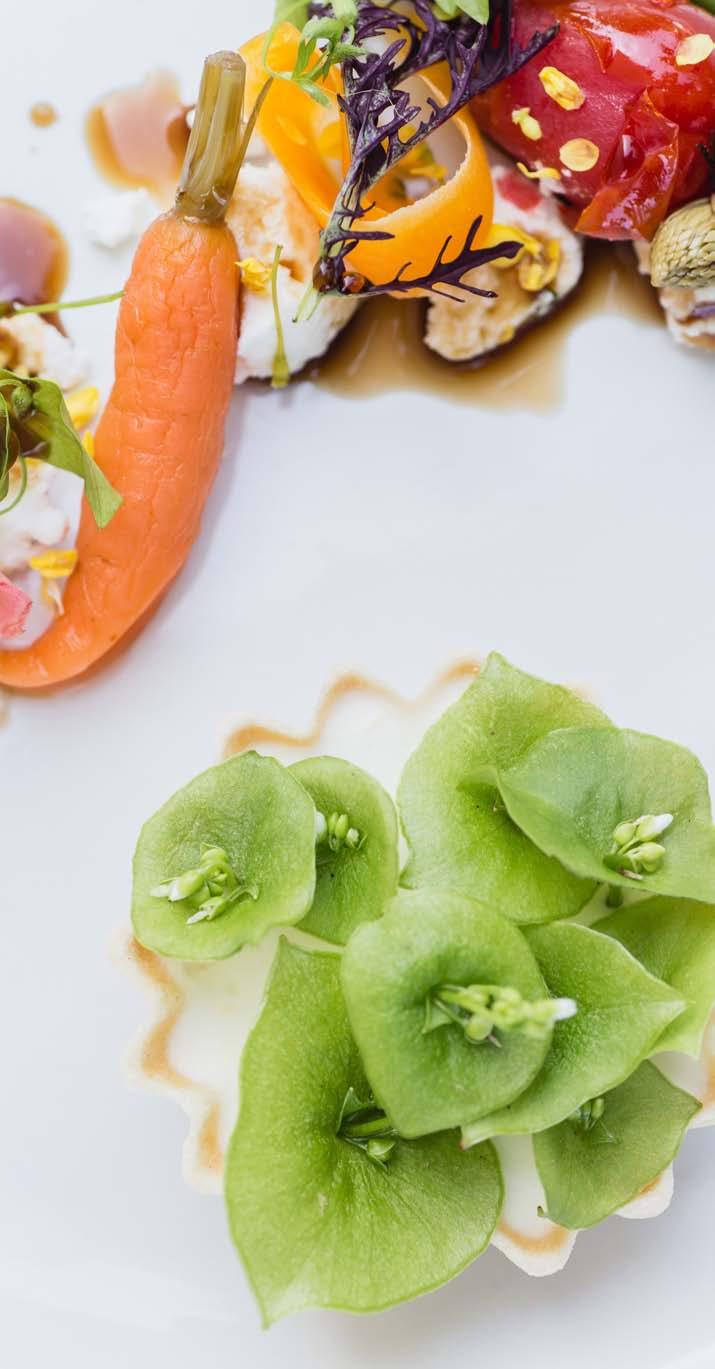
Please note this safety tip: to avoid bacterial contamination, any marinade used on raw food should not be brushed on again during cooking, unless you boil it for a few minutes. And any marinade brushes and other utensils that are used on raw food should not be used again near the end of cooking.


• Portuguese piri-piri chili paste, blended with roasted red peppers and garlic, is wonderful on chicken or steak.
• Chipotle en adobo mixed with yogurt and lime juice, cumin and coriander, or chipotle mixed with mayonnaise, is amazing on salmon skewers.
• Yogurt, garlic, smoked paprika and lemon juice does wonders for any protein.
• Harissa, olive oil, lemon zest and toasted and ground cumin also complements protein.
• Soy sauce, sesame oil, minced garlic and ginger, lime juice and Japanese mirin (or honey for sweetness) on both fish and meat.
• Tequila, orange and lime juices, ancho chili powder and brown sugar is great on fish and seafood, especially prawns.
• Herbaceous pesto or chimichurri are welcome at any time. Both are perfect for vegetables, lamb or other protein. Pesto can be mixed with yogurt or mayonnaise for a vibrant and creamy dip.
• Salsa fresca is also a versatile condiment to have at the ready, especially when tomatoes are fresh from the farmers’ market. If you’re not making your own, hunt down the Frontera Brand by chef Rick Bayless for roasted green or red salsas. They’re bold and balanced and only involve unscrewing a lid.
• A sprinkle of salt should never be underestimated; it enhances and heightens flavours. While regular sea salt is fine, I prefer the readily available chili-lime salt from the Tajin brand. Maldon salt flakes are exquisite and crunchy, and the herb and spice-infused salts from Vancouver Island Sea Salt Co. and Sooke’s Saltwest provide myriad choices to keep you kebab-ing all summer.
THERE IS NO SINCERER LOVE THAN THE LOVE OF FOOD
- George Bernard Shaw
Think again if you believe soup is only for chilly days. In Bogota Colombia where's it's wickedly hot, this robust soup is just part of their daily routine. Inspired by a trip I recently took, I took some liberties with original recipe and layered in summery twists (hint: fire up the bbq!). Surprisingly enough, this hot and hearty soup will keep you cool as a cucumber.

Colombians serve white rice; I like nutty brown basmati.




Guascas is an essential flavouring that looks like stinging nettles and tastes like artichokes.



Green sauce from the Root Cellar is a great stand-in for sour cream. Drizzle over soup.
Make with three types: Fluffy brown russets, delicate red-skinned and creamy papa criolla—a traditional Andean potato. (Tip: available frozen at Mexican House of Spice on Douglas St.)

Serves 6
SOUP
2 each bone-in chicken breasts and thighs, grilled or smoked
3 ears fresh corn, shucked
5 garlic cloves, smashed
1 red onion, thinly sliced
8 cups chicken broth
3 russet potatoes, peeled and coarsely chopped
3 red-skinned potatoes, peeled and coarsely chopped
4 papa criolla or 2 Yukon gold potatoes, peeled and coarsely chopped
⅓ cup guascas
½ cup chopped cilantro
Sea salt and black pepper, to taste.
GARNISH
1½ cups cooked rice
1 avocado, sliced
¼ cup capers, drained
Green sauce (buy at the Root Cellar) or sour cream and hot sauce, to taste Lime wedges
Remove skin from chicken; cut meat from bones and thinly shred meat; set aside. Place bones in a large stockpot.
Scrape kernels from corn; set aside. Cut cobs in half; add to pot along with garlic and half the onion.
Pour broth and 4 cups water into stockpot. Bring to a boil, then reduce heat to medium. Partially cover and simmer for 45 min. Strain and save broth; return broth to pot. Stir potatoes and guascas into broth. Bring back to a boil, then reduce heat to medium and simmer, partially covered, for 15 min.
Stir in chicken, corn, remaining onion and cilantro. Continue to simmer until potatoes are soft and start to fall apart, 10 more minutes. Taste and season with salt and pepper.
To serve: This soup is all about the garnish. Ladle soup into bowls (hint: always warm bowls first!) and serve the garnishes - remaining onion, cooked rice, sliced avocado, capers, extra chopped cilantro, lime wedges and green sauce on the side in small bowls so guests can help themselves.

Acai bowl! Cloud eggs! Poke! Bone broth! Ube doughnuts “Oh, you haven’t had charcoalinfused vegan ‘nice’ cream?!?!” my Instagram screams at me as I scroll through my morning feed.
“No, I haven’t,” I think to myself. “OMG, have I been missing out!” Apparently, you haven’t lived until you’ve tried … what was it again? A ramen burger? A turmeric latte? A space-aged steak? Cold-pressed-fish-oil-infused Jell-O?… Keeping up with online trends can be exhausting but oh, it is so much fun to try.
The Internet is a weird and wonderful place for food these days. If we think back even 10 years ago, food trends lived very much in the real world. They existed on top of white tablecloths, served by waiters with long black aprons. They were discovered between the pages of Cooks Illustrated, Bon Appetit and Food and Wine. They were the topic of conversation at dinner parties and whispered on the streets as they were slowly revealed through word of mouth. Food as a means of social currency was reserved for a select few. It lent itself only to those who had access to money, knowledge and insider information. Today, access is granted to all who care to be engaged, and the trends are pushed into the real world and on to your tabletop by the sheer power of social media analytics (or perhaps these trends are driven by a shadowy research group hell bent on getting you to buy oversized soup dumpling. Who knows these days?).
Social media has democratized food culture. It has opened up access to anyone who knows their way around BuzzFeed and Instagram. The trends, the secrets and the insider information are available to all in an instant. Local slow-food Instagrammer and blogger Lyndsey Eden has seen how the viral nature of social media has made food from around the world more accessible. “It has opened up people’s minds to recipes they may never have tried before, giving them an experience of another culture’s food [and] broadening their palate.” The downside of the food-focused social media experience, she says, is that “it has made our society a little food obsessed. It can cause an internal struggle for people. We are an increasingly visual world and we love to eat with our eyes instead of
eating what our bodies actually need.” Access and choice are wonderful if we are able to make the right (and restrained) choices.
The largest shift in food as a social currency is that you are no longer required to eat it or even have physical access to it in order to be a part of it. No one cares if you haven’t actually eaten mochi, they only care that you know what it is. You simply have to be educated, which by today’s standards is a quick scroll through Instagram or a glance at any one of the hundreds of food listicles that pops up in your daily news feed.
The gents behind the wildly popular Vic Food Guys Instagram account, Dallas Harwood and Mike Scharien, know how fast and far their posts can travel. “In a world where any given day’s feature dishes are readily previewed and ‘hidden gems’ are not staying so hidden, social media has allowed for word to travel much faster than ever before.” There are no secrets when it comes to food and social media. The trick is to get there first before it becomes a viral trend and inevitably fades into obscurity.
A food trend can become a global phenomenon in a matter of days and takes virtually no time to express itself in the real world. A craze that starts in Japan can migrate in an instant to New York and then be up and running in your neighbourhood in … well, how long does it take to get a food truck up and running? That’s the measure of time I’m using here.
The coveted trophies of foodie privilege are no longer truffles, caviar, rare cheeses or choice cuts of meat. They’re a pop-up taco stand, a new Korean barbecue truck or the latest iteration of the Cronut (see Rainbow Bagel, Sushi Donut and whatever weirdness celebrity pastry chef Dominique Ansel is cooking up (BTW, today it’s Flowering Hot Chocolate). Rosé became the drink of the summer, seemingly out of the blue (or Millennial pink, as it were) because of social media, with sales up 54 percent in 2017, outpacing the overall wine category by 4 percent. “Rosé All Day” made its way on to sweatshirts and hats and flashed across every relevant millennial foodie account in the heat of July and August. This is food culture driven by the digital masses sustained by likes, shares, reposts and the almighty hashtag.
What we see burn across the Internet on a daily basis has a very real impact on the food we eat. Social media drives competition and creativity in the food industry and pushes it to be more affordable, more ethical and more inventive than ever before. One of the struggles for the food industry is to adapt to these demands in a way that assures the sustainability of catering to these trends. Opening a full-scale bricks and mortar is a huge risk, with high overhead costs and no guarantee of success. We have seen this play out in quite dramatic fashion here in Victoria with chefs and restaurateurs favouring more risk-adverse alternatives such as food trucks, counter-service spots, pop-ups and, more recently, chef-focussed delivery services. Responding to a fast-paced, trend-driven market demands a shift in the way we think about both serving and consuming food.
Social media has also changed who gets to participate in the food scene. The base is broader, younger, faster and more demanding. They have an awareness of choice, understand ingredients better than ever and expect honesty, transparency and authenticity in their food. They’re Millennials and most of them are broke, so you better impress them for under $10. Social media and online engagement hasn’t just changed who has a say in what’s on trend and what just fell off the back of the bus but also in who is doing the actual cooking. A good home cook with a killer social media account can make the move from Instagram to cookbook or cookshack pretty seamlessly and will take that online following offline and turn it into sales. Social media has drastically changed the food landscape. Food, as part of a lifestyle, is now accessible and inclusive. Anyone is invited to have an opinion—in fact, the more opinions the better. We are crowdsourcing our demands from the food industry and pushing for more creativity, more sustainability and more inclusiveness. The Internet and social media have democratized the food scene, and despite some of the utter nonsense that comes out of the constant buzz (avolatte be gone), food is in the middle of one of the most creative eras it has ever enjoyed.

I like to eat food that is lighter in the summer. These veg and fruit-filled spring rolls will satisify your craving for variety and fresh without weighing you down.
Serves 6
4 oz (100 g) cooked rice vermicelli
2 Tbsp (30 ml) rice vinegar
6 (each 8 inches/20 cm) rice paper wrappers
Filling options
Fresh herbs (e.g., mint, basil, cilantro)
Edible flower petals
2–2 ½ cups (500–625 ml) finely sliced vegetables (e.g., chioggia beets, carrots, radish, watermelon radish, zucchini, red cabbage, cucumber)
Green peas
Chopped fruit (e.g., cherries, peaches, blueberries)
Pea sprouts, or your preferred sprouts
Sprinkle the rice vinegar over the noodles. Prepare a bowl of warm water. Quickly dip one piece of rice paper in the water and then place it on a clean work surface. Place your choice of herbs, edible flower petals, vegetables, fruit, and noodles on the bottom half of the rice paper, leaving the top half and the outer edges free
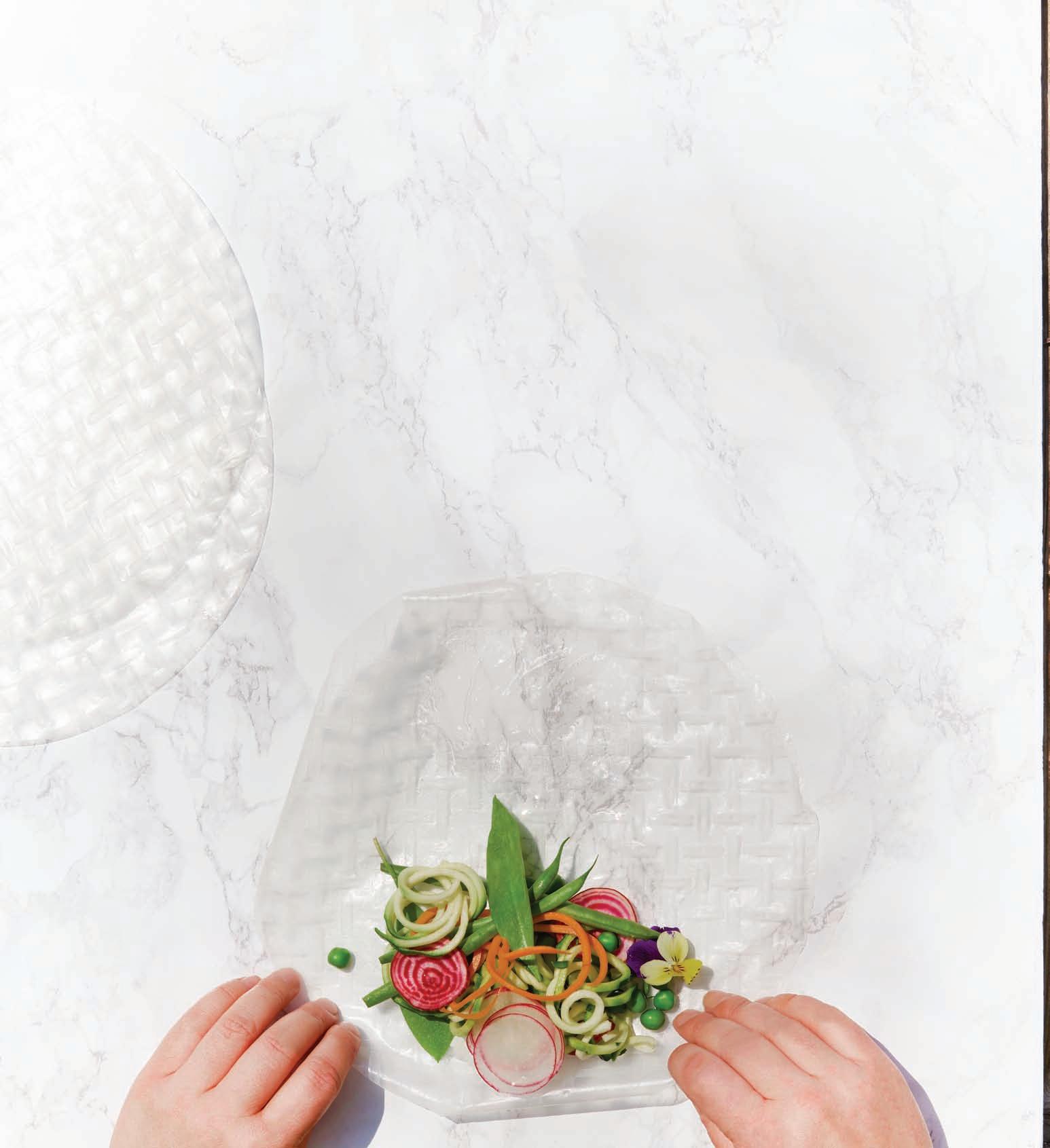
of fillings.
Fold in the sides of the rice paper and roll it up tightly. Wrap the roll in plastic wrap and chill until needed. Repeat with the remaining ingredients.
½ ripe peach, diced
2 Tbsp (30 ml) yellow mustard seeds
2 Tbsp (30 ml) vegetable oil
1/3 cup (80 ml) rice vinegar
2 Tbsp (30 ml) honey
2 Tbsp (30 ml) Dijon mustard or to taste
In a small saucepan over medium-high heat, sauté the peaches and mustard seeds in the oil for 2 minutes. Add the rice vinegar, turn down the heat to low, and then add the honey and Dijon. Allow to cook for 25 minutes. Cool before serving.
ASIAN SAUCE
1 Tbsp (15 ml) coconut sugar
Juice and zest of 1 lime
1/4 cup (60 ml) rice vinegar
3 Tbsp (45 ml) water
1 Tbsp (15 ml) nuoc nam (fish sauce)
1 small bird’s-eye chili, sliced in rounds
In a small bowl, dissolve the sugar in the lime juice. Add the remaining ingredients.
TAHINI SAUCE
3 Tbsp (45 ml) tahini
1 clove garlic, minced
1/2 inch (1 cm) fresh ginger, grated
3–4 Tbsp (45–60 ml) water
Juice of 1 lemon
1 Tbsp (15 ml) soy sauce
In a small bowl, mix together the tahini, garlic, and ginger. Add the water, lemon juice, and soy sauce and whisk well to incorporate until the mixture is smooth.

Or, how I learned to stop worrying a half-litre at a time.
STORY: DANIEL MURPHYUp here in The Great White North, bargain purchases in a liquor store are less common than verified Sasquatch sightings. It’s still God’s country, with its quasi-Socialist perks, a few stands of large trees that have evaded wood-chippers , and a handsome, charismatic and ineffectual figurehead. But maintaining all of these things requires vast sums of cash. This helps explain what happens with the net annual revenue of the BC Liquor Distribution Board, which consistently hovers around a billion dollars. Yes, you read that correctly: net annual revenue. For perspective, the combined federal and provincial debt has been projected at $1.4 trillion, so it’s really just a small drop of wine in a very large barrel. So, as dutiful Canadians, there appears to be only one course of action—swill our national debt away, saluting as we hand over our life savings to the liquor store cashier. But for beer drinkers, there is still one relatively high-return investment on Canadian liquor store shelves. They can be found at all liquor stores, in various placements, some lined up on ice like cold candy right at the counter, others standing tall in their refrigerated fortresses like imposing totems. The “Tall Boy” is a 500 mL can sent directly from the Beer Gods to appease mankind’s worry and unease.
TRADITIONALLY, IT’S BEEN EUROPEAN IMPORTS THAT HAVE BEEN the most readily available: Konig, Estrella, Stiegl and Grolsch, with a few other mass-produced geographical outliers like Sapporo (Japan) and Steinlager (New Zealand). Average price on these icy sentinels is between $1.90 and $2.50. Extrapolate that out to the volume of a regular six-pack, and you’re likely getting these beers at a cheaper rate than anything else (save for the really low-grade North American “lagers”), while at worst getting the same volume and a hefty upgrade in flavour and craftsmanship. Although at one time this packaging format flew relatively under the radar, things have changed rapidly. In their bid to entirely saturate the beer market, huge corporate brewing conglomerates have packaged their products in as many forms as humanly possible, including cans of all conceivable size. But this format also holds one major upside for smaller, independent brewers: production cost. Beer is (relatively) inexpensive to manufacture. Packaging costs are (relatively) expensive. If you can sell more beer volume in less packaging, your cost to produce the finished product goes down. If you can then sell this same-volume/lesspackaging model at a similar retail price, therein lies the real win. For instance, a four-pack of Tall Boys at the same price as a six-pack of regular cans will net the brewery a much better margin on the sale. The hurdle for the average small brewery is that installing a canning line is an unrealistically expensive investment, usually upwards of half a million dollars. Sensing a growing need in the market, a couple of “mobile canning” operations have started up, offering a portable packaging option for younger/smaller breweries that haven’t yet amassed the cash flow to expand in that direction. This has allowed smaller Victorian brewers to inhabit the same shelf space as established European and hugescale North American breweries—albeit while handing over a portion of their already slim margins to the canning facilitators.
Phillips’s move into the format. It’s an interesting bias, which predates B.C.’s enthusiasm for this particular packaging option. But the B.C. market has been lucky enough to benefit from Phillips’s expansion decision. “Once we went into that format, it was a no-brainer to supply our own local market as well,” says Phillips. What began with an offering of their staple Blue Buck pale ale has now evolved into a preferred format for their niche, experimental beers, a shift from what would usually have been the role of a more traditional 650 mL “Bomber” glass bottle.
It’s a sentiment echoed by Driftwood Brewing Co.’s part-owner and “Wizard of Wort”
Jason Meyer: “We feel as though it’s ‘the New Bomber,’ in a sense.” The Bomber signified a seismic shift for craft beer, giving small breweries a market edge—a simplified, small-scale filling system with more beer per selling unit (increasing margins) and incredible flexibility in terms of short production runs. Beer labels usually cost pennies,
The hurdle for the average small brewery is that installing a canning line is an unrealistically expensive investment, usually upwards of half a million dollars. Sensing a growing need in the market, a couple of “mobile canning” operations have started up, offering a portable packaging option for younger/smaller breweries that haven’t yet amassed the cash flow to expand in that direction. This has allowed smaller Victorian brewers to inhabit the same shelf space as established European and huge-scale North American breweries—albeit while handing over a portion of their already slim margins to the canning facilitators.
But even then, it hasn’t been a bulletproof avenue to success, as Clayton Potter, brewmaster/owner of Moon Under Water Brewery and Pub, can attest. As the first brewer in Canada to utilize a mobile canning service, it wasn’t easy going in the beginning. “Even though it’s more practical for us, the tall cans were stuck on shelves with [those of larger breweries], and we still couldn’t compete at their price point. People were looking for something cheap or something exotic, and I don’t think they were expecting local craft beer to be there.” But sticking with it has paid dividends, and tall cans of their Light Side of the Moon session lager now account for 75 percent of Moon’s total packaged sales. What changed?
“I think it comes down to the liquor stores themselves embracing tall cans. We’re still not convinced we could survive on just can sales, but ideally we could invest in our own canning line, and only bottle specialty brews.”
For the more established Phillips Brewing Co., the move into tall cans came as a side effect of expansion into the Ontario market. Owner Matt Phillips points to a seemingly “unofficial policy” of Ontario’s government liquor stores as the catalyst for
as opposed to purchasing huge runs of individualized cans. But to stay ahead of the curve, Driftwood plans to offer selections from their core range in cans (yes, including Fat Tug IPA), in both tall and regular sizes, by the end of this summer. “I don’t feel that short cans are out of favour, but tall cans will be our main focus, based on demand.”
There have also been unforeseen drawbacks from the big-can format. During tenancy negotiations, one local liquor store was informed by their landlord that they were specifically prohibited from selling tall, single cans if they wanted to sign the lease. It appears the stigma associated with this format being a magnet for an “unpleasant element” has not yet been completely outmoded. But the times they are a-changing, and I strongly suggest getting on board with one of the last, lonely “deals” on the liquor store shelves, for—if nothing else—the health of the Canadian economy.
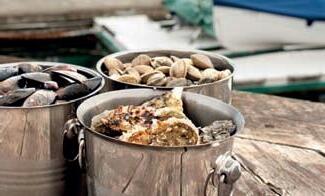





THIS YEAR MARKS A SPECIAL ANNIVERSARY FOR HESTER CREEK WINERY. Fifty years ago, Joe Busnardo converted a derelict peach orchard into a vineyard just outside the Okanagan town of Oliver. The 76-acre site on an east-facing bench was perfect for quality wine grapes. At the time, B.C.’s wine industry was based on hybrids and labrusca grapes, hearty, prolific but not known for producing quality wine. Going against prevailing wisdom (that Vitis vinifera couldn’t survive Canadian winters), Busnardo purchased more than 80 varieties of classic European grapes.
The harsh winter of 1978-79 proved Joe Busnardo correct. The vinifera survived; many hybrids did not. Divino Winery opened in 1983 and after several hard years was sold and rebranded as Hester Creek Winery in 1996. Stability arrived when Prince George businessman Curt Garland purchase the winery in 2004.
Hester Creek celebrates the 50th anniversary of Joe Busnardo’s original vineyard on the Golden Mile Bench with events focused on selected blocks of Pinot Blanc, Trebbiano, Merlot and Cabernet Franc. These 50-year-old varieties represent some of the oldest vines in B.C.
This past April, Hester Creek winemaker Rob Summers and Laurel Point executive chef Takashi Ito hosted a five-course winemaker’s dinner to celebrate the anniversary. Most winemaker dinners pair wines to dishes, but chef Ito created dishes to complement the wines.
The reception featured a refreshing 2017 Rosé Cabernet Franc and a trio of hors d’oeuvres. The rosé’s sweet fruit and crisp acidity worked well with the salty-savoury components in the coppa, pepper boursin and lychee pinwheel; olive and chickpea tapenade; and tomato bruschetta cone. The fish course featured a 2017 Trebbiano paired with a medley of scallops, spot prawns, octopus and trout gravlax—salty, sweet and briny. The wine, rich and viscous with mouth-searing acidity and a very dry finish, was paradox in a glass. A splendid pairing.
Next up, pork tenderloin wrapped in prosciutto with yam gnocchi paired with a Syrah-Viognier, a veritable Côte-Rôtie knockoff. The blend of 85% Syrah/15% Viognier was a revelation, and chef’s pork tenderloin brought out the best in this fine blend. Lamb with a shiitake ragout and red pepper coulis followed, a delightful synergy between wine and lamb.
Chef Ito played our palates with his creative use of ingredients and textures to focus our attention on aspects of each wine. The dessert by pastry chef Kimberley Vy was over-the-top delicious, paired with a Late Harvest Pinot Blanc with sufficient fruity intensity and acidity to hang in there with Vy’s tribute to all that’s sweet and good.
Hester Creek Rosé Cabernet Franc 2017 Okanagan Valley $19.95
After a 48-hour cold soak, the fruit is pressed off the skins and fermented in stainless steel. As lovely to look at as to consume with its pretty pink hue, subtle aromas of pink grapefruit, strawberry and spice on the nose. Just off-dry with lush berry nicely balanced with a hint of soft tannin.
Hester Creek Old Vines Trebbiano 2017 Golden Mile Bench $23.95


The only Trebbiano produced in British Columbia. The grapes are sourced from the oldest vines in the vineyard, hand-harvested and whole-berry pressed. Cold fermented in stainless steel for four months, the wine has a rich viscosity, rapier-like acidity and vibrant stone fruit flavours.
Hester Creek Syrah-Viognier 2015 Golden Mile Bench $26.95
After harvest, the grapes are fermented together on the skins for 15 days before being pressed off and aged in a combination of French and American oak for 15 months. Bright and floral on the nose with smoky fruit and silky smooth tannins.
Hester Creek Block 2 Reserve Merlot 2015 Golden Mile Bench $28.95



The fruit was put through an extended maceration and fermented to dryness, then after malolactic fermentation aged in French and American oak for 16 months. Rich and hearty with heady aromas of black cherry, vanilla and spice. On the palate this heady Merlot has concentrated fruit nicely balanced with soft tannins.

Hester Creek Late Harvest Pinot Blanc 2015 Okanagan Valley $17.95

Not quite icewine but at a third the price, this little sticky is a great replacement. Lush with honey, juicy pear and apricot flavours, refreshing acidity and a long sweet finish.

Hudson’s On First
Award winning dining in a beautifully restored heritage home. Local ingredients, classic techniques and made from scratch cooking are a just few reasons to visit us in Duncan more often. Celebrate Bubbles & Brunch, Lunch and Dinner.

163 First St. Duncan, BC, 250-597-0066, hudsonsonfirst.ca
Duncan Garage Café & Bakery
Chill out with us this Summer. We've got plenty of frozen treats and frosty drinks - all deliciously healthy. Pack a picnic with our great to go meals and desserts or take a break from the sun and eat inside.
330 Duncan St., Downtown Duncan (across from the railway station), 250-748-6223
Adrienne’s Restaurant & Tea Garden
Join as on the patio for one of our great ALL DAY BREAKFASTS. Or spend an afternoon with us for Antipasto or Ploughman’s platter, High Tea, or desserts and drinks. Kid-friendly menus are available.
Open daily, book your reservations, 250-658-1535. 5325 Cordova Bay Road, Victoria, BC, AdriennesTeaGarden.com

Whisk
Bring on Summer! Enjoy Barbecue season with our new stylish leather aprons and mitts. Other stylish aprons in big and tall sizes. Pizza grilling stones, vertical chicken roasters and cast iron grills, all in stock at Whisk.
whiskvictoria.ca Open 7 days a week
HOME & KITCHENWARE

Stick in the Mud
The Stick has been roasting specialty coffee in Sooke since 2010. Freshly roasted wholesale coffee beans are now available in Victoria. Free delivery to the region. Commercial equipment also available. Call for details. 778-352-0077

FernwoodRoad Café
A funky little café with an incredible view, great coffee and lots of home baking - for breakfast, lunch and dessert. Spring Hours (closed Wed) Weekdays 9 - 5, Weekends 10 - 5
325 Fernwood Road ( just across from Fernwood dock, north end) Salt Spring Island, 250-931-2233, Fernwoodcafe.com
IT’S IN OUR HANDS. HAND-CRAFTED BREAD MADE WITH FRESHLY STONE-MILLED FLOUR AND ONLY CERTIFIED ORGANIC OR SUSTAINABLY GROWN LOCAL INGREDIENTS . NATURALLY LEAVENED AND BAKED TO CRUSTY PERFECTION IN WOOD-FIRED BRICK OVENS. 1517 QUADRA ST.

Victoria Public Market 778 433 9184




























